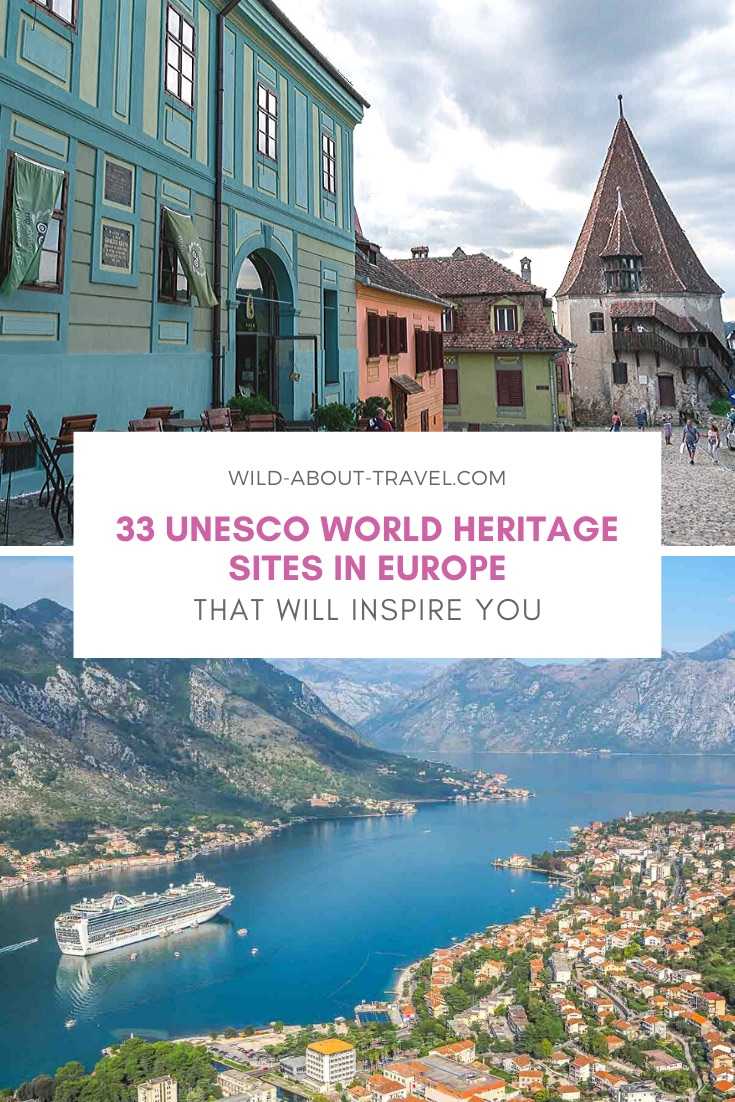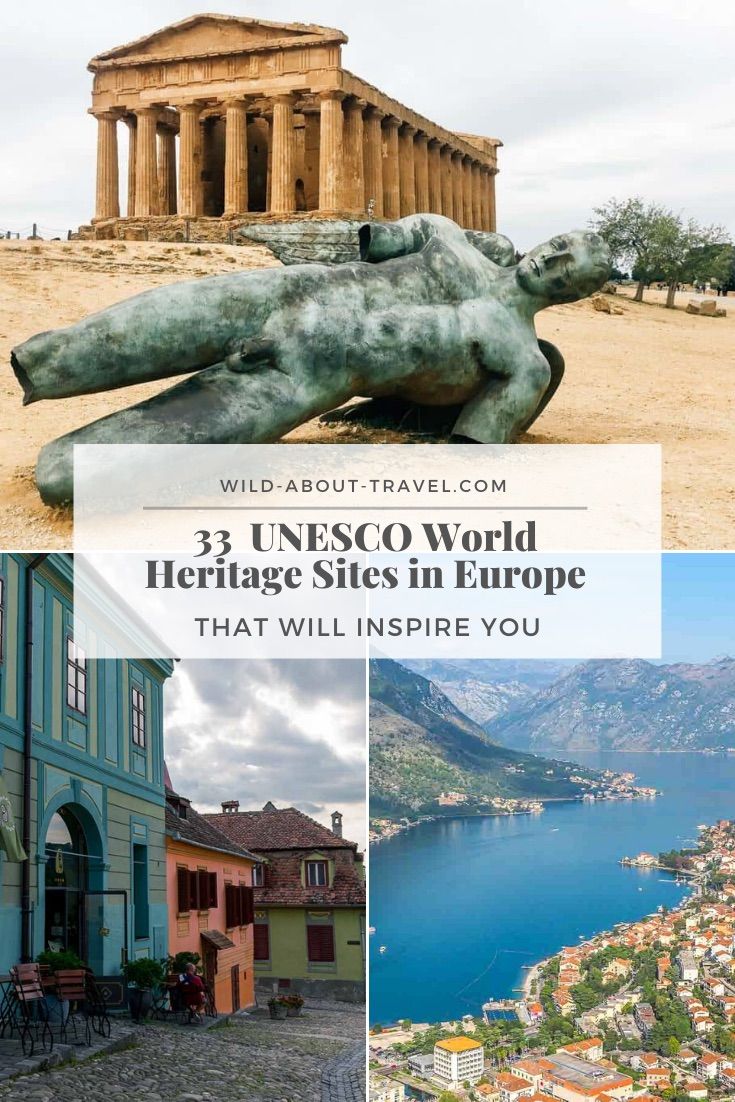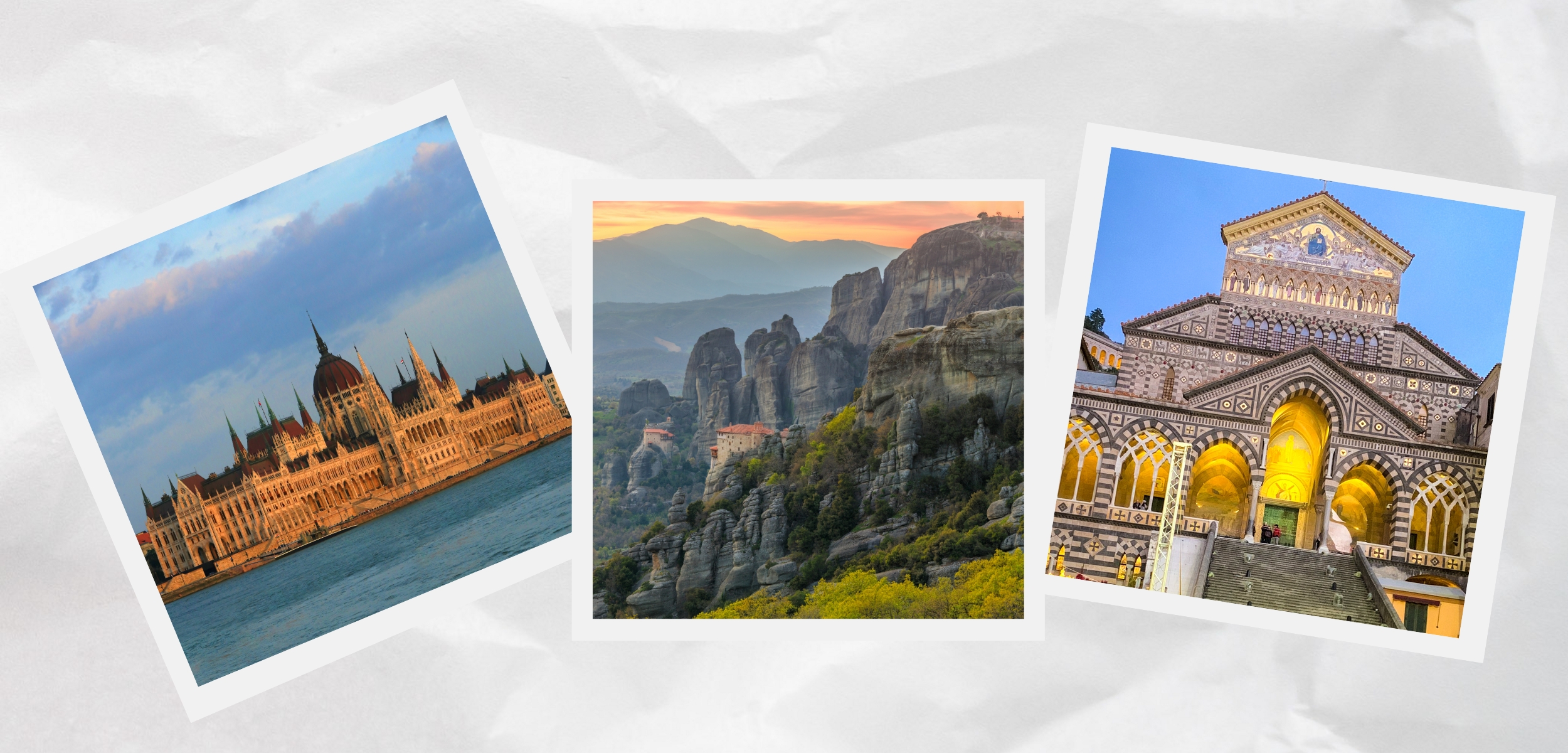Whoever visits the old content, no matter how many times, likely wants to discover at least one of the many beautiful UNESCO World Heritage Sites in Europe. Some are well-known, but there are plenty still under the radar.
Although I visited quite a few UNESCO sites in Europe and around the world, there’s a multitude I still have to discover. That’s why I asked fellow travel bloggers to recommend Europe World Heritage Sites they consider unique. The result is a list of landmarks, including unmissable European UNESCO World Heritage Sites, some of which I’m pretty sure you may never have heard of. I certainly hadn’t.
UNESCO World Heritage Sites in Italy
I’m starting with Italy not only because it’s my birthplace but also because Italy is the country with the highest number of UNESCO World Heritage Sites in Europe and in the world.
The Dolomites, Italy
by Claudia Tavani, My Adventures Across The World
The Dolomites well deserve to be listed among Italy’s UNESCO protected sites. Ascribed in 2009, this mountain chain spreads across the regions of Trentino Alto Adige, Friuli and Veneto, in north-eastern Italy, with 18 peaks above 3000 meters. The Dolomites are home to a variety of ecosystems and unique wildlife.
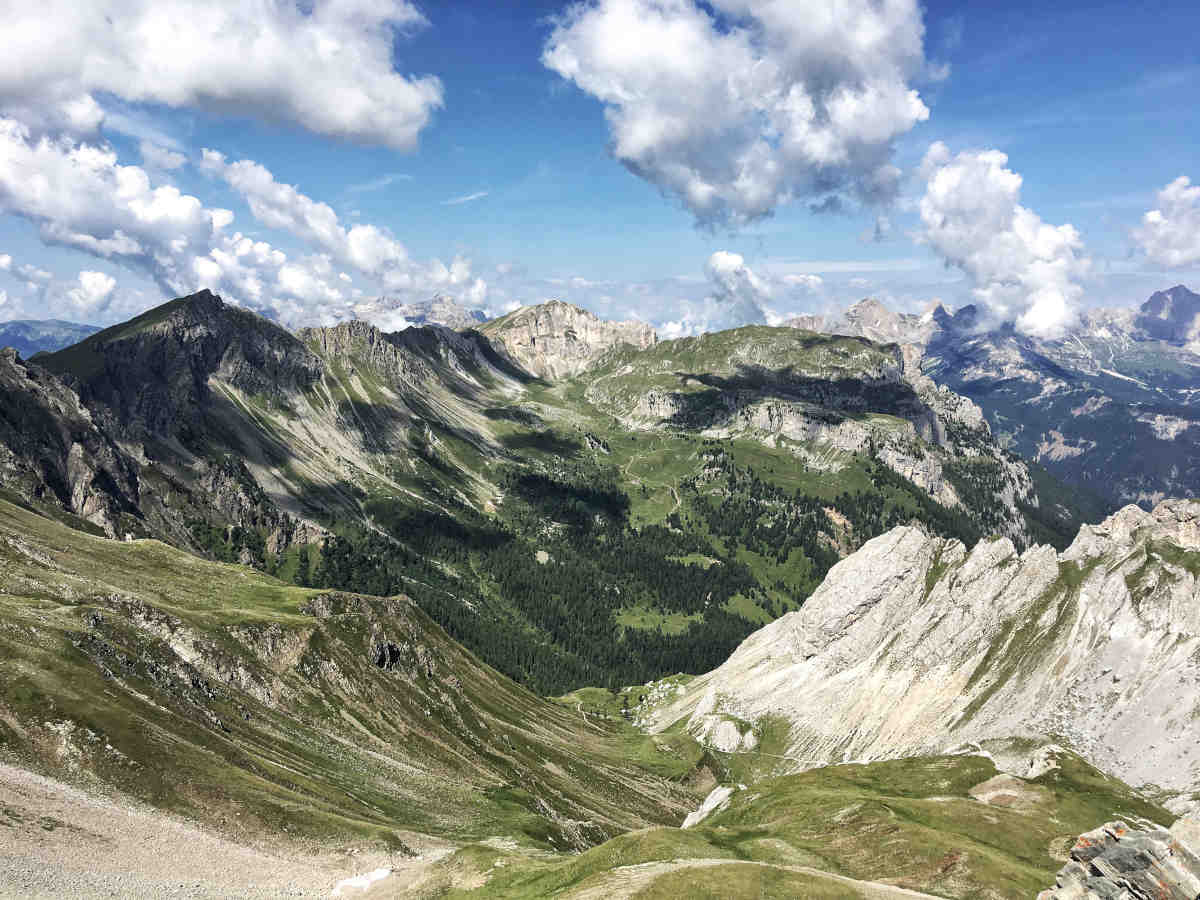
Those visiting the Dolomites usually remain mesmerized by the beauty of the landscape. Picture breathtaking views of mountain peaks and glaciers, sheer cliffs that call to be climbed, deep, long valleys, fairytale-like forests, boisterous rivers, and endless meadows.
Scattered around the side of the mountains and valleys are small cities and scenic villages perfect for a lazy stroll and where you can enjoy local hospitality. The food in this part of the country is rich, comforting, and simply mouthwatering, and you can pair it with crispy, fruity wines.
Needless to say, the Dolomites call for adventure sports. Winter is a great season to visit, as the mountains get covered in snow and you can go skiing or snowboarding.
During the spring and summer months, the Dolomites are all about hiking. There are hundreds of trails of varying length and difficulty, many of which are also suitable for families with children. Some trails are easy to reach and follow and can be completed within a few hours. Others require an expert guide and – for the most challenging ones – days of walking, going from one mountain hut to the other.
The Dolomites are also a perfect destination for thrilling adventure-seekers. There are plenty of activities to choose from, including white water rafting, canyoning, and tandem paragliding.
Last but not least, the Dolomites are home to an incredible cultural and musical event – I Suoni delle Dolomiti (“Sounds of the Dolomites”) whereby between June and July concerts are held at different times of day (look out for sunrise concerts for a truly special atmosphere) in the open, nature being the perfect amplifier for the music played.
To know more, read also: Are you Craving Holidays in the Dolomites? These Photos Will Inspire You
Amalfi Coast, Italy
by Lori Sorrentino, Travlinmad
To the south of Naples, Italy is the Sorrentine Peninsula with the scenic and historic Amalfi Coast, now one of the UNESCO World Heritage Sites in Europe. Facing the deep blue of the Tyrrhenian Sea, the coast is a patchwork of citrus and olive groves and vineyards set against the black rock of the mountainsides that seem to tumble into the sea. There are beaches, small bays, scenic overlooks, and ancient ruins all along the coast.
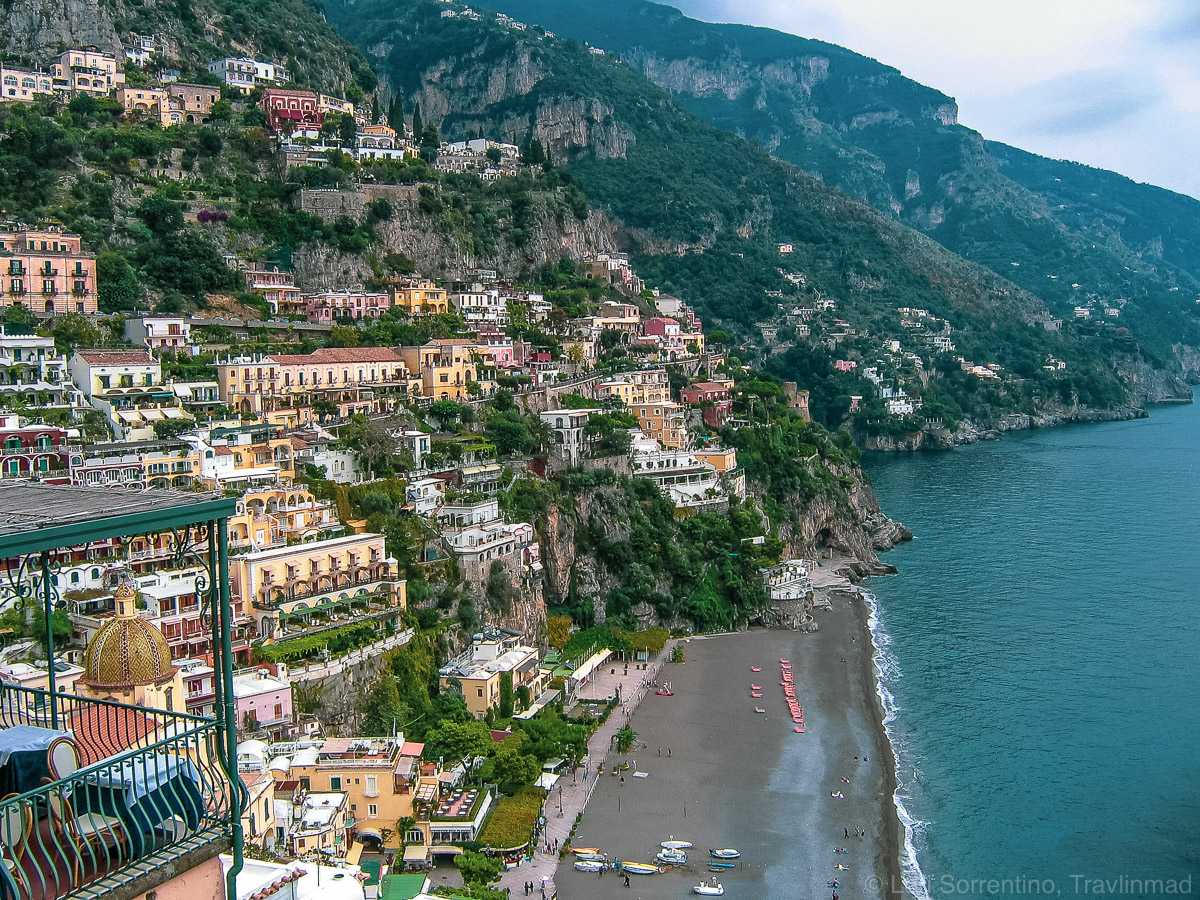
Perhaps the biggest reasons that the Amalfi Coast draws crowds are the charming towns perched along the coastline and high in the hills. Luxe and colourful Positano has long been the jewel of the Amalfi Coast and the Italians’ choice for a holiday. They’ll tell you there are so many things to do in Positano that you just have to visit, at least once.
You may want to read: One Day in Napoli – The Ultimate Guide to the Best of the City
Praiano has clusters of white houses, and the dome of its church is covered with bright, colourful majolica tiles. The town of Atrani, farther along the coast, doesn’t get many tourists and remains authentic, making it well worth a visit to experience a local unchanged coastal town. Then there is Amalfi itself for which the coast is named. Established in the 4th century BC Amalfi was long the seaport for trading goods between the East and the West. The Duomo Sant’Andrea Apostolo, with its incredible staircase and cloister, is one of the most visited cathedrals on the coast.
350 meters (1148 feet) above Amalfi is charming Ravello, another gem overlooking the coast. Visitors should spend the day strolling the town and visiting Villa Cimbrone with its spectacular gardens.
We recommend basing yourself in Positano to take advantage of the “topless” buses that travel back and forth to Amalfi and up to Ravello throughout the day.
If you don’t feel like visiting the Amalfi coast by yourself or you’re short of time, you can join a group tour. There are excellent day excursions to Amalfi from Naples, one of which also includes a visit to the Roman town of Pompeii. Furthermore, although it’s more of a rush, you can also take a day trip from Rome to Amalfi and the stunning coastline.
Rome, Italy
by Angela Corrias, Rome Actually
It was so hard to declare a single monument as a UNESCO World Heritage Site in Rome, that the whole city centre, the Vatican and Saint Paul Outside the Walls Basilica were enlisted in 1980.
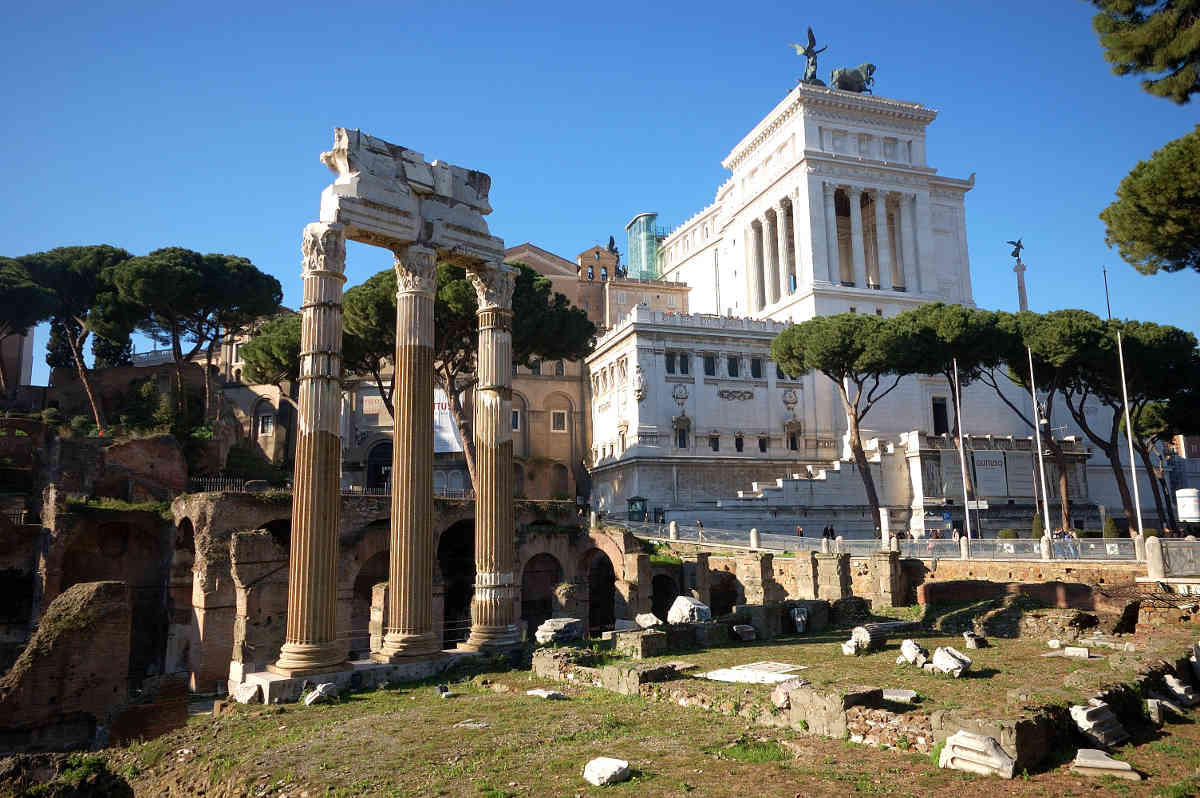
Visiting the archaeological sites of the Colosseum, Roman Forum, Palatine Hill, Imperial Fora, up to the Circus Maximus, and the Caracalla Baths is the best way to get an idea of how Rome was founded and how its great civilisation started from its very heart. These are not the only relics from imperial times, but the best starting point to understand how was life in Rome thousands of years ago.
Rome city centre wasn’t listed by UNESCO only for its historical vestiges but also for the stunning artwork from the Renaissance and Baroque periods. Anyone visiting Rome for the first time can’t miss places like Piazza Navona, the beautiful square built on top of Domitian Stadium, the Pantheon, ancient temple of all gods, Piazza del Popolo near Villa Borghese park, Piazza di Spagna (the Spanish Steps) and important basilicas like San Giovanni in Laterano, Santa Maria Maggiore and San Paolo Fuori Le Mura.
One day, or at least half a day, should be devoted to the Vatican City, the world’s smallest country nestled between Prati and Trionfale neighbourhoods. Places like St. Peter’s Square and Basilica, the Vatican Museums that include the famous Sistine Chapel, the Vatican Gardens and the fascinating necropolis underneath St. Peter’s Basilica are strictly linked to the history of Christianity, its development and centuries of artwork commissioned by the popes and donated by kings and leaders from all over the world.
It’s been said that a lifetime is not enough to see and appreciate everything that Rome has to offer. What better reason to come again and discover more about the Eternal City.
Read also: 3 Days in Rome: How to Plan a Unique Trip to the Eternal City
Assisi, Italy
by Izzy & Phil, The Gap Decaders
Assisi is a glorious, spectacular and beautiful homage to religion. Deep in the Umbrian hills of Italy, this UNESCO World Heritage Site is the birth and burial place of St Francis, founder of the Franciscan order of monks and patron saint of Italy.
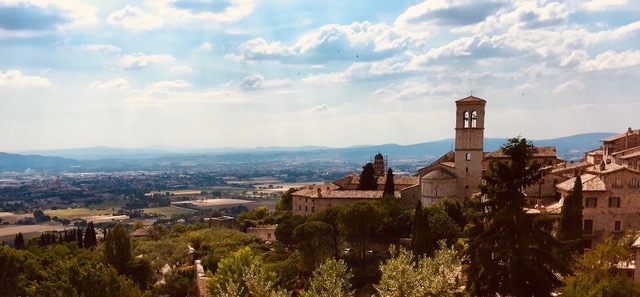
This historic site includes the buildings of the Basilica of San Francesco d’Assisi along with at least nine other important religious buildings. Constructed in the creamy stone local to the area, this town of steep twisting alleys and attractive squares is full of pilgrims (and tourists) wending their way towards the imposing and dramatic Basilica, which hugs the western flank of Monte Subasio and can be seen from miles around.
You don’t need to be religious to immerse yourself in Assisi’s churches, castles, art and culture. The Basilica is a must-see, along with the simple yet beautiful Eremo delle Carceri where St Francis retreated to pray. You should also visit the 14th-century Rocca Maggiore, a castle that sits at the highest point in Assisi and affords spectacular views of the quintessential Italian countryside.
You need an overnight stay or at least a full day in Assisi to fully soak up the unique and beguiling atmosphere. It will be very busy in July and August, we would recommend June or September for the perfect weather and quieter attractions. Make sure you dress appropriately, covering your knees and shoulders on entering churches.
Eat at Hosteria Nova Baccanale Cafe in the upper part of town. The food here is simple, showcasing local flavours such as wild boar and truffle alongside a good wine list. They sometimes have live music which adds the ambience of this family-run eatery.
Stay at Nun Assisi, with its immaculate modern bedrooms, tranquil lavender-filled gardens and sleek spa in the ruins of a Roman amphitheatre. You will be well looked after in this converted monastery, which, like Assisi itself, is chock-full of history, atmosphere and charm.
Assisi, and the Umbria region, are beautiful and worth a dedicated trip. You can, however, get a taste of this unique area on a day trip to Assisi and Orvieto from Rome.
Matera, Italy
by Halef and Michael, The Round The World Guys
Matera is a beautiful and ancient city in southern Italy’s Basilicata region. The historic areas here are the two Sassi – Sasso Caveoso and Sasso Barisano. Both are surrounded by the more modern part of the city.
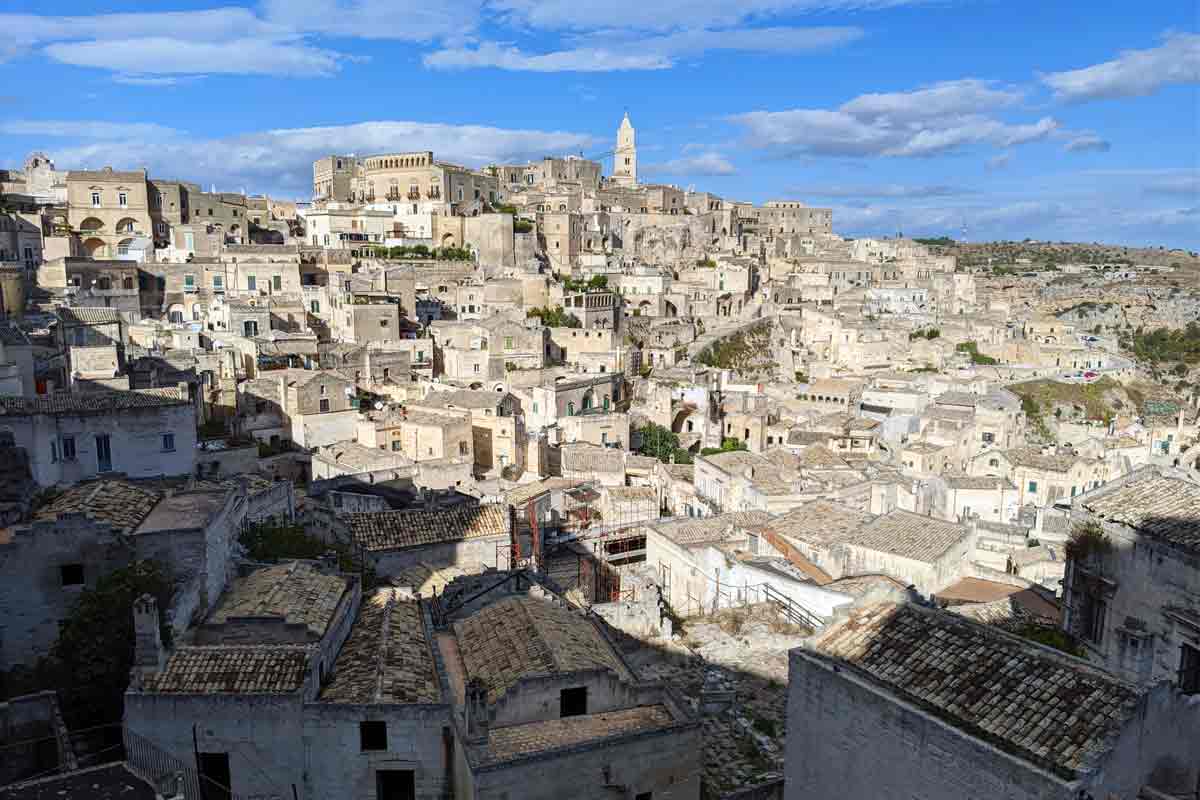
People have been living in Matera for over 7000 years, and you can see some of the evidence of it in Matera’s many prehistoric caves dwellings. Each cave extends into limestone cliffs and boulders. Matera is the third-oldest continually-inhabited settlement in the world.
To know more, read also: Basilicata Region: A Journey To Discover Authentic Italy
Life was not easy for the people of Matera. Sassi di Matera was condemned by the government as unfit for human habitation, and the city was evacuated in the mid-1950s. Thankfully, much-needed restoration in the 1980s turned Matera into a beautiful place to live for both residents and tourists.
Matera became one of the UNESCO World Heritage Sites in Europe in 1993. In 2019, Matera was chosen as a European Capital of Culture. You might even recognize the city as the set of a few popular movies, including Mel Gibson’s The Passion of the Christ and the James Bond film, No Time to Die.
Be ready with a pair of good walking shoes, plenty of energy and curiosity. Everywhere you walk in Sassi di Matera, you will find something interesting. And that’s the best way to enjoy the city – wandering around and getting lost along the narrow pathways.
Valley of the Temples, Agrigento, Italy
by Katy Clarke, Untold Italy
Just two hours from Palermo or Catania you will find one of the most fascinating UNESCO World Heritage Sites in Sicily. The Valle dei Templi (Valley of the Temples) is a series of Ancient Greek temples dating back over 2 millennia and were built on the site of the former city of Akragas.
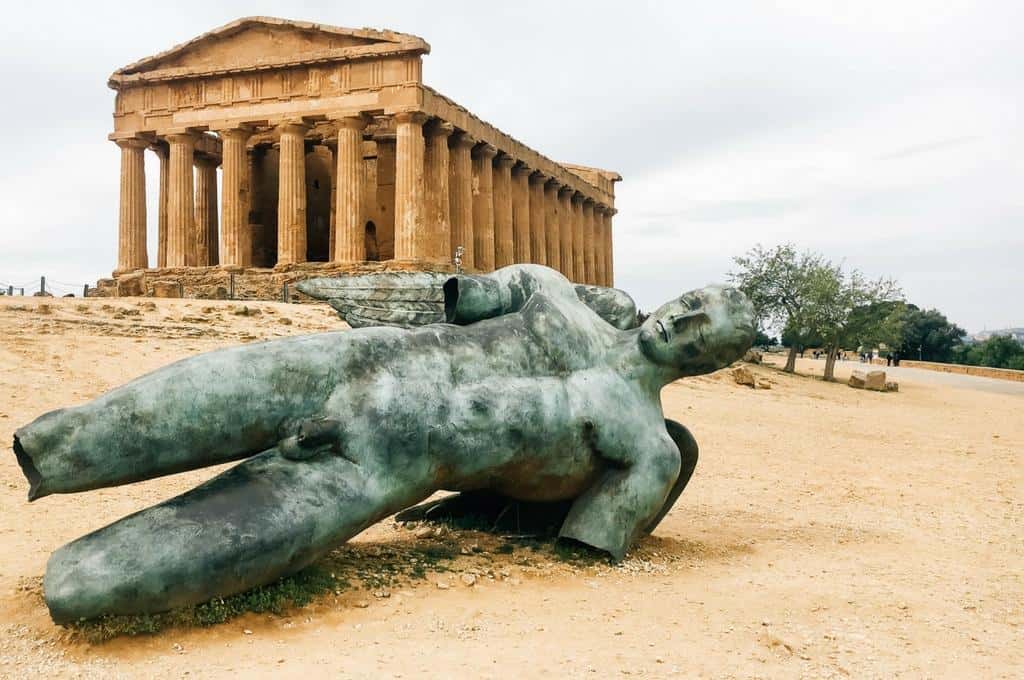
Once a thriving city with a population of half a million people, Akragas stood for 1000 years. When the Greeks were defeated in Sicily in 406AD, the city was abandoned and forgotten for centuries. The site was revitalised in the 19th century and has undergone research and restoration ever since.
You can spend several hours exploring the Valley of the Temples but don’t expect a valley. The site is located on a ridge with stunning views out over the Mediterranean. The most impressive temple still standing is the imposing Temple of Concordia. It stands almost 17 meters high and was first built in around 440BC. It features 78 columns decorated with flutes or ridges in the Doric style. Start at one end of the 2.5-kilometre long site and follow the main trail past temples, dwellings and even the city’s baths. Other points of interest include an ancient necropolis and burial ground.
Make sure to bring plenty of water and sunscreen as the ridge is exposed to the elements. The best way to get to Agrigento and the Valley of the Temples is by car. Or, for a more relaxing experience, you could join a guided tour from Catania.
Southern Europe UNESCO Sites
Italy aside, Southern Europe is extremely rewarding in terms of heritage sites. Some of the UNESCO sites in Spain are nothing short of magnificent and among my favorites. And that’s just the tip of the iceberg!
The Real Alcazar in Seville, Spain
by Alison Nicholson, Alison in Andalucia
Seville is one of Andalucia’s most beautiful cities with the Real Alcazar being the jewel in its crown.
The Moors started building the Alcazar in the 10th century. It was finished several hundred years later by the Christians who had conquered Seville. Additions and restoration works were carried out over the years. Therefore, the current structure is a unique blend of architectural styles which was recognised by UNESCO in 1987 when the Alcazar was granted World Heritage status.
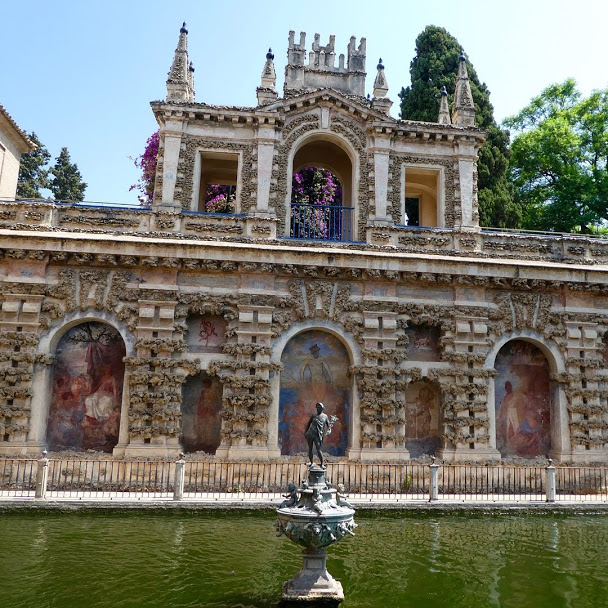
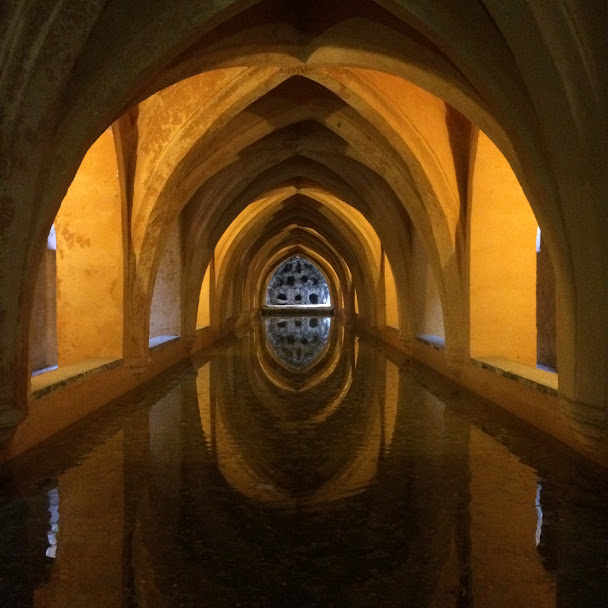
Entering the Alcazar through the iconic Lion’s Gate is like stepping back in time. Archways with intricate carvings lead to courtyards and patios. Walls adorned with frescoes and decorated with typical Andalucian ceramic tiles and extensive gardens where you can wander with the scent of orange blossom hanging in the air.
If you’re a fan of Game of Thrones, you’ll recognise parts of the Alcazar as the fictional Water Gardens of Dorne, including the Baths of Lady Maria de Padilla beneath the Patio del Crucero which shouldn’t be missed.
There’s a small café in the grounds where you can have a beer or coffee on the terrace while you enjoy your surroundings – usually with a peacock or two at your feet.
I recommend buying skip-the-line tickets to the Alcazar in advance online. When you arrive at the entrance, you’ll see two queues. The shorter queue is for those who already have their tickets. So why waste time waiting in line when you could be inside enjoying all that the Alcazar has to offer?
Cordoba, Spain
by Paulina, Paulina on the Road
Cordoba is probably one of the most beautiful places to visit in Spain. Why? Because it reunites the best that offer touristy towns such as Granada or Seville, but still, Cordoba isn’t inundated with tourist masses.
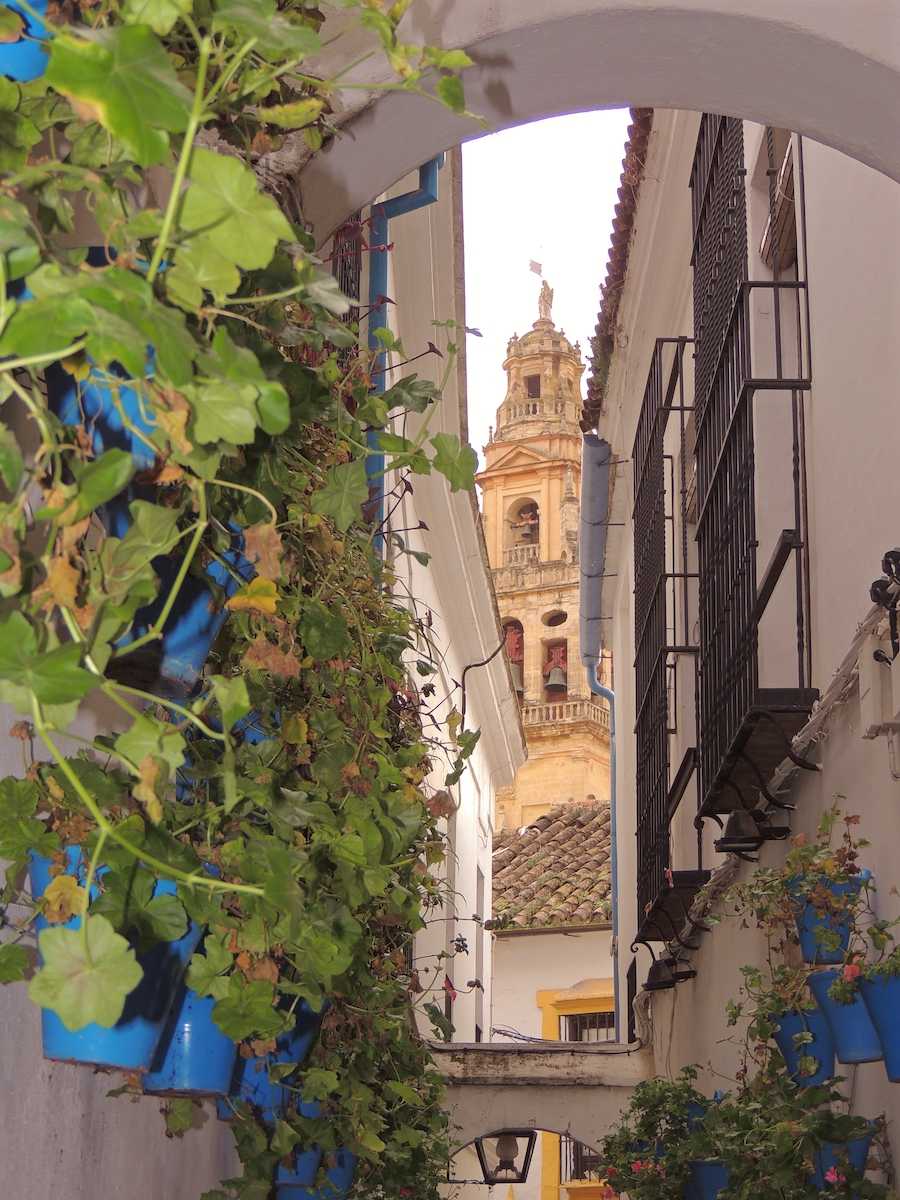
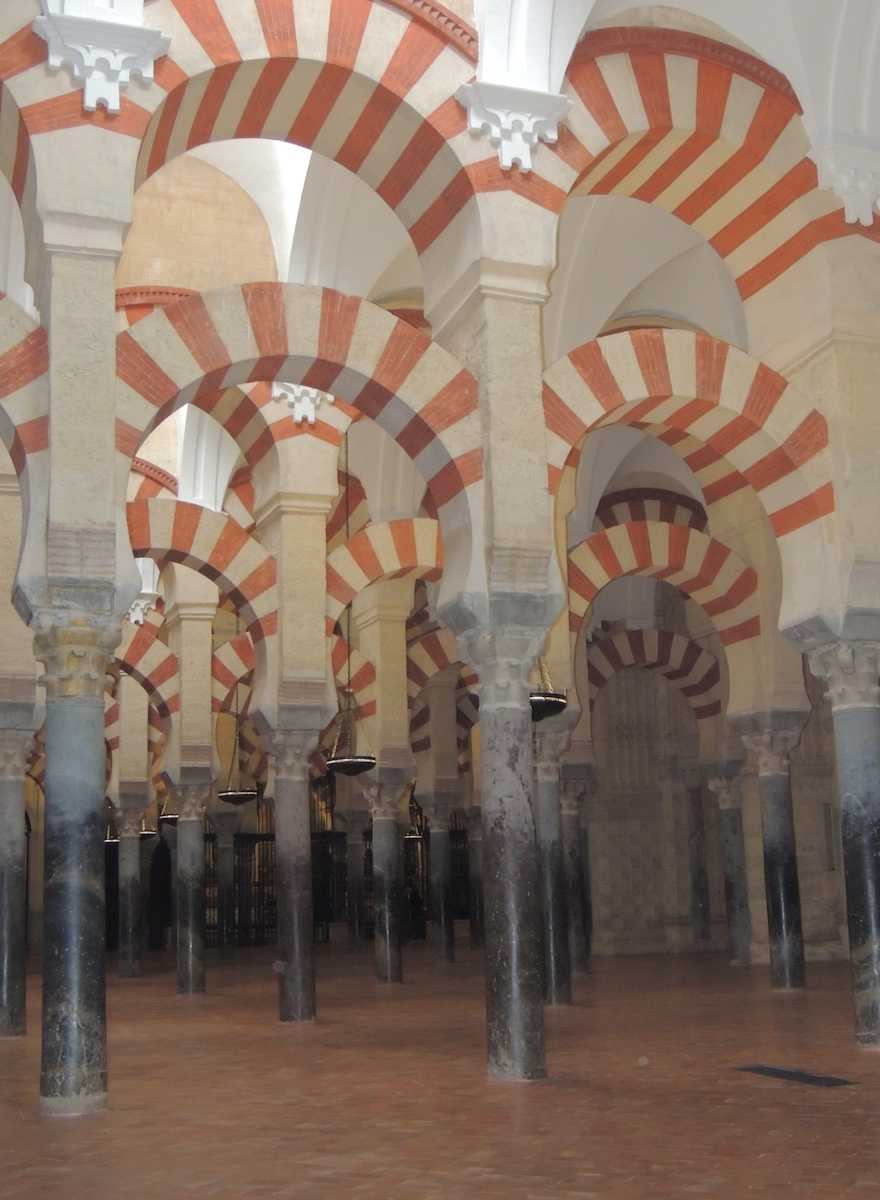
Only a few are aware that the historical city centre of Cordoba is declared UNESCO World Heritage. Why? Because during the period of emperor Augustus, the splendour of Cordoba rivalled with the one of Constantinople, Baghdad and Damascus. At that time, Cordoba counted over 300 mosques and palaces!
This made the city very attractive for philosophers and writers. Without any exaggeration, Cordoba was at that time the cultural capital of the Western world.
Located in the heart of Andalucia province, Cordoba is very easy to reach and thus one of the best day trips from Malaga.
I recommend visiting during spring or autumn, as temperatures can rais up to 40°C in summer. Some of the best things to do in Cordoba are visiting the majestic cathedral, the patios with flowers and eat salmorejo, a typical cold soup from Cordoba.
Oviedo and the Kingdom of the Asturias, Spain
by Christina, Travel2next.com
Located in northern Spain between stunning mountains and the coastline, Oviedo is the capital of the Asturias region. A city with a rich history, founded in AD 761, it’s not surprising that the Monuments of Oviedo and the Kingdom of the Asturias are one of the most beautiful UNESCO World Heritage sites in Spain.
What makes this World Heritage site worth visiting is its unique history. Although it was tiny, the Kingdom of Asturias played a considerable role in the history of the Iberian Peninsula. It was a significant hub for Christianity during the 9th century and walking around Oviedo reveals a legacy of stunning pre-Romanesque palaces and churches that draws crowds of visitors each year.
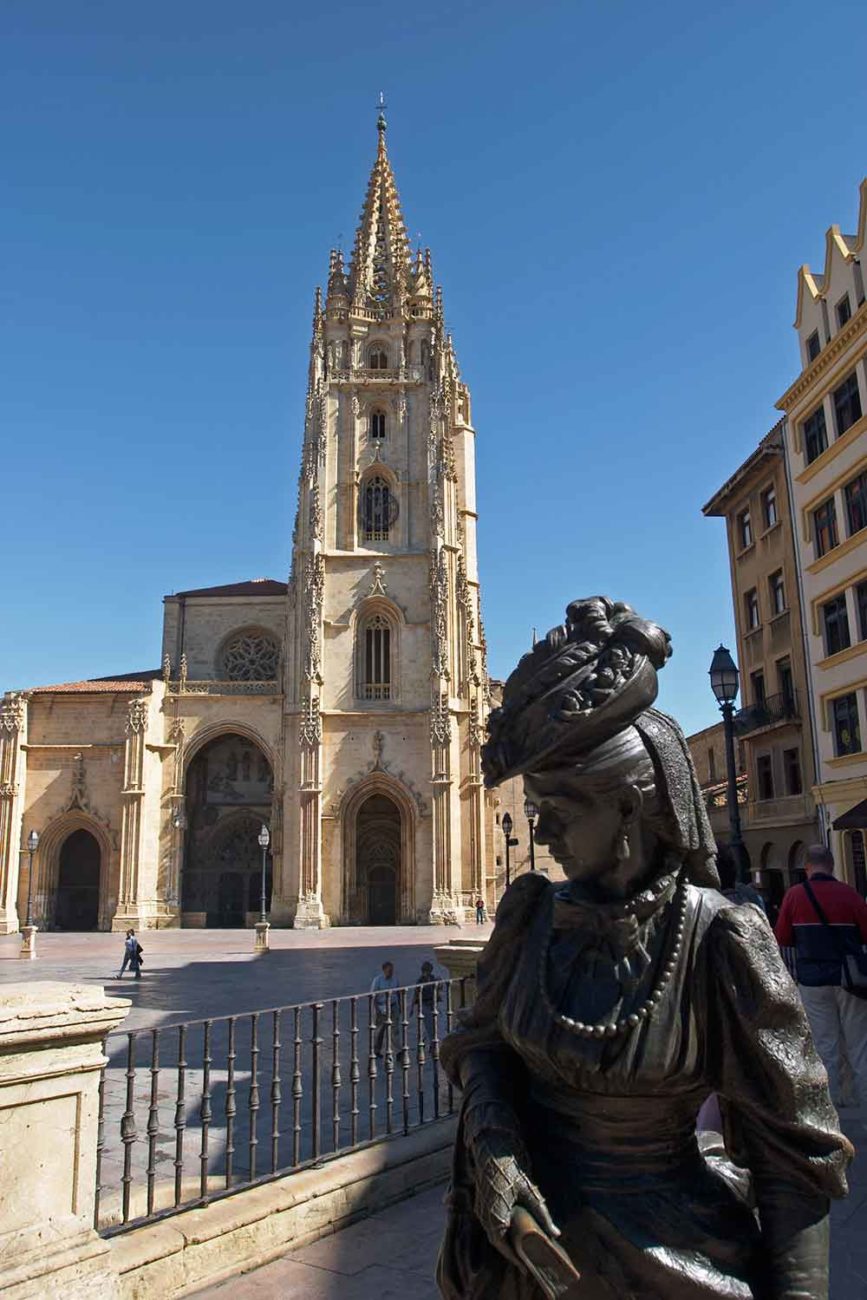
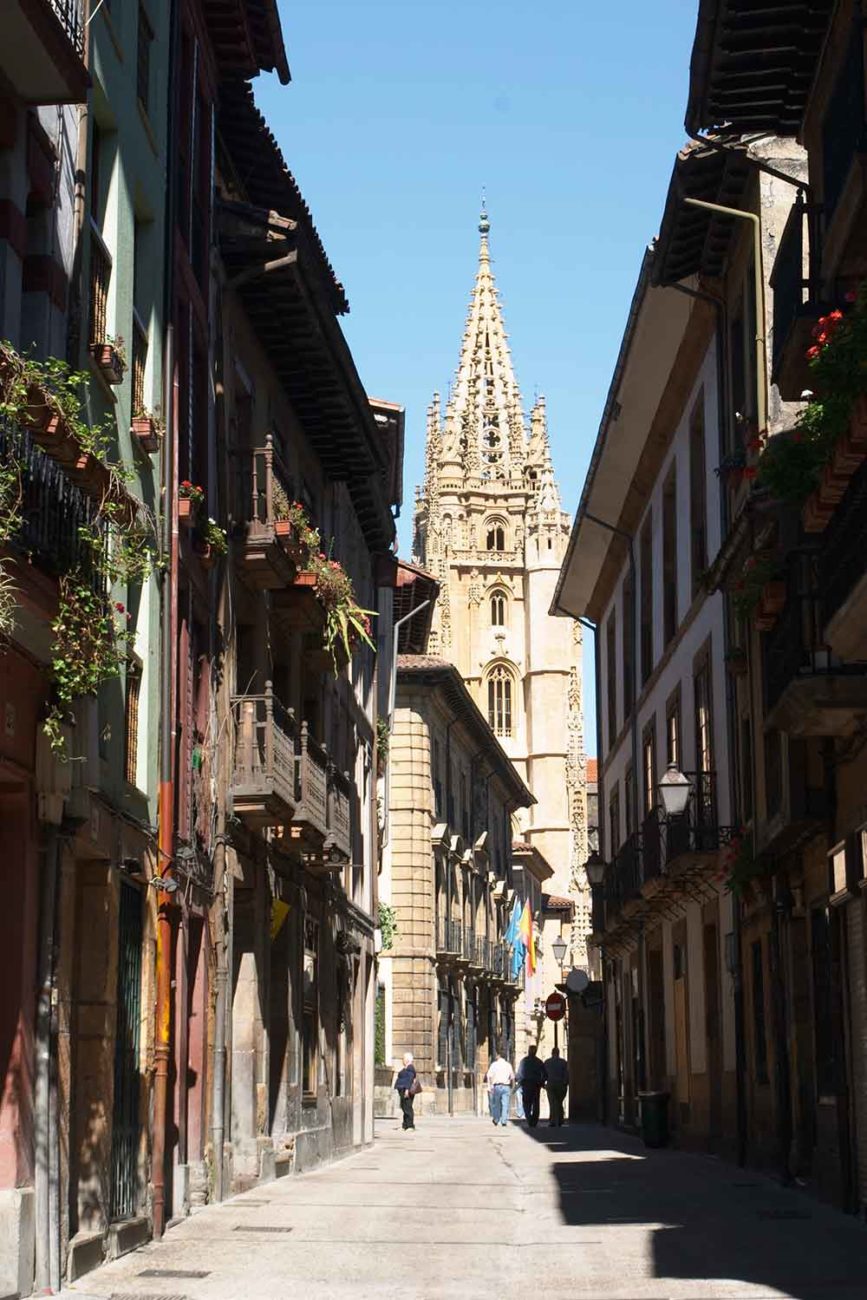
Some of the most beautiful examples of Asturian architecture are Santa María del Naranco, which was formerly a Ramiran royal residence that became a church. Also see Santa Cristina de Lena, San Miguel de Lillo and the Cathedral of Cámara Santa.
This World Heritage site also has an impressive Middle Ages hydraulic engineering structure, La Foncalada, which was based on a Roman model.
One of the things to do in Oviedo is to go on a walking tour of the city’s plazas, where you will see many interesting sculptures. Take a photo with La Regenta (the regent’s wife) by Mauro Álvarez in Plaza de Alfonso II el Casto, which is in front of the Cathedral of San Salvador.
The best way to explore Oviedo on foot and fortunately, along the way, you’ll find many excellent local restaurants that serve excellent food. Look for fresh seafood, local sausages and cider.
Valletta, Malta
by Vanda, The Yogi Wanderer
For such a small country, Malta features an impressive total of 8 UNESCO World Heritage Sites: six megalithic temples, the hypogeum, and the fortified city of Valletta.
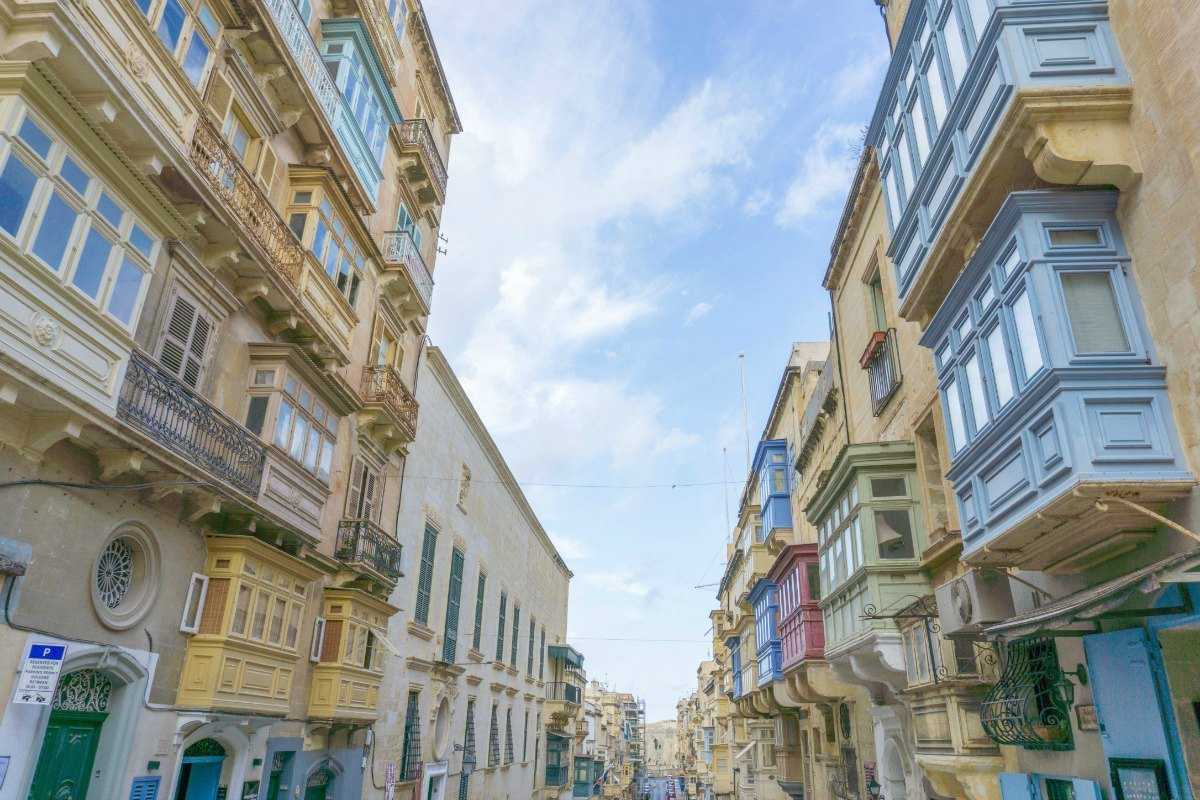
Valletta was built in the 16th century by the Order of the Knights of St John as the new Maltese capital. It was added to the UNESCO list in 1980 due to its Renaissance urban plan, remarkable Baroque architecture, and rich history. In fact, wandering around the beautiful city of Valletta is like travelling back in time to an age of knights and castles.
Valletta is also the smallest capital in the European Union, which makes it perfect for exploring by foot. Make sure to save at least one day to see all the city has to offer – and it’s not little despite its tiny size.
Some of the best things to do in Valletta include admiring the stunning views from the Upper Barrakka Gardens, visiting the majestic St John’s Co-cathedral, and taking a tour in the typical Maltese gondola, the dghajsa.
History buffs and art lovers should not miss Valletta’s world-class museums, from the Grand Master’s Palace to the MUZA National Museum of Art, the National Museum of Archeology, or the National War Museum.
Valletta is also a paradise for shoppers and foodies alike, with Republic and Merchant Streets being the epicentre of the city’s commercial activity and gastronomic scene.
In recent years, the Maltese capital has also emerged as an eclectic and sophisticated nightlife destination, with many new pubs, cafés, and wine and jazz bars opening around the city.
The old city of Mostar, Bosnia and Herzegovina
by Rai, A Rai of Light
Mostar, a city in Bosnia and Herzegovina located along the Neretva River, is known for its amazing Stari Most or better known as the Old Bridge.
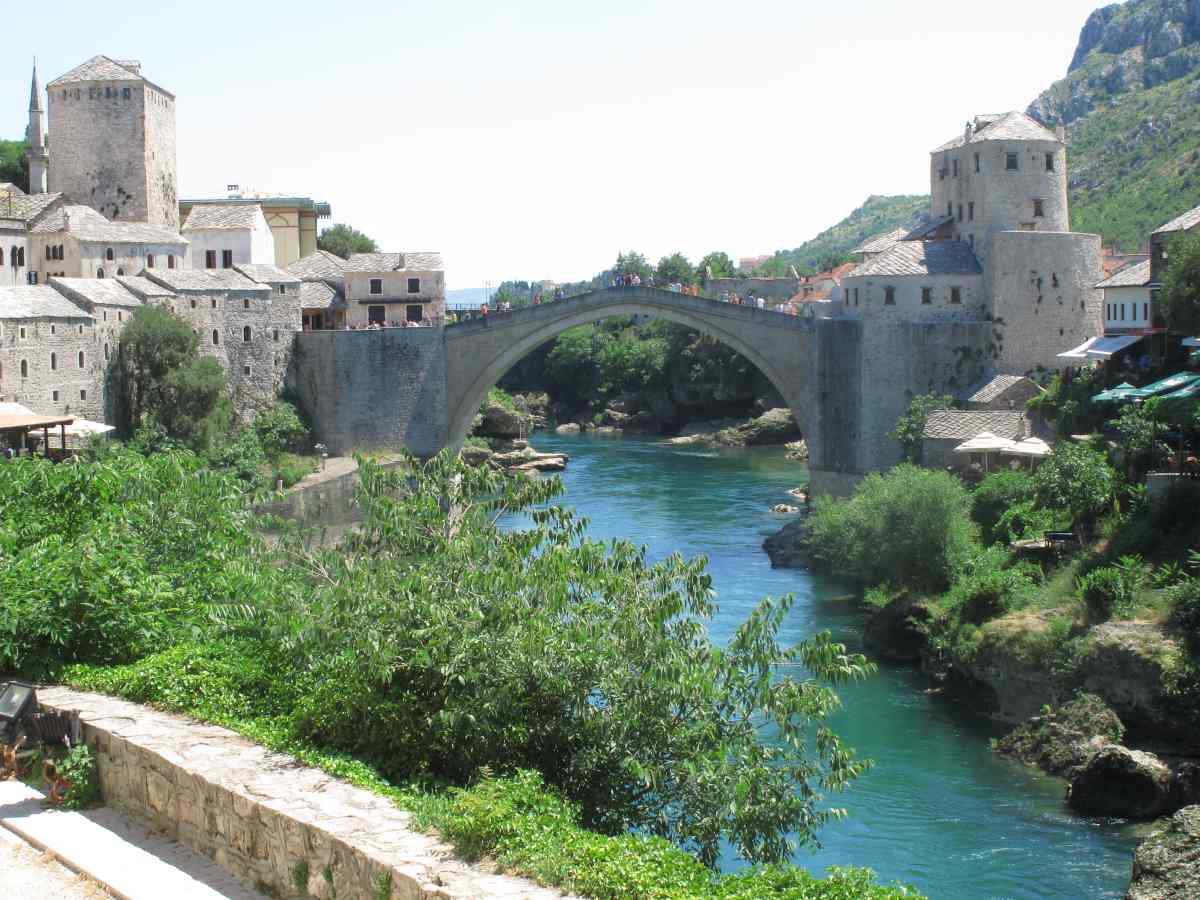
This medieval arched bridge, constructed in the mid sixteen century, was entirely destroyed in the Bosnian war when it was targeted by intentional artillery fire due to its strategic and cultural importance in the city. It has been reconstructed and reopened in 2004 and today serves as a cultural and economic centre of the city.
In 2005 the bridge and the area surrounding it were enlisted on the UNESCO World heritage, serving as the cultural and economic centre of Herzegovina. Standing at a height of 42 meters, the old bridge is also known for another unique tradition of young men jumping off from the bridges’ highest point diving into the water below. They have been doing so ever since the bridge was built, and this act gathers crowds who view the spectacle with delight.
The Old Bridge Area is a vibrant, tourist place and market with many restaurants, souvenir shops. It is a beautiful place to spend a few hours and learn about the history of the city. Other interesting features in the area include a small bazaar, an Ottoman house, and a small mosque open to the public.
Plitvice Lakes National Park, historic Trogir, and the old city of Dubrovnik, Croatia
by Zach & Julie Ruhl, Ruhls of the Road
Croatia is a wildly beautiful country from top to bottom. In this beautiful country are, among other things, 3 of the most incredible UNESCO World Heritage Sites in Europe: Plitvice Lakes National Park, the historic city of Trogir, and the old city of Dubrovnik.
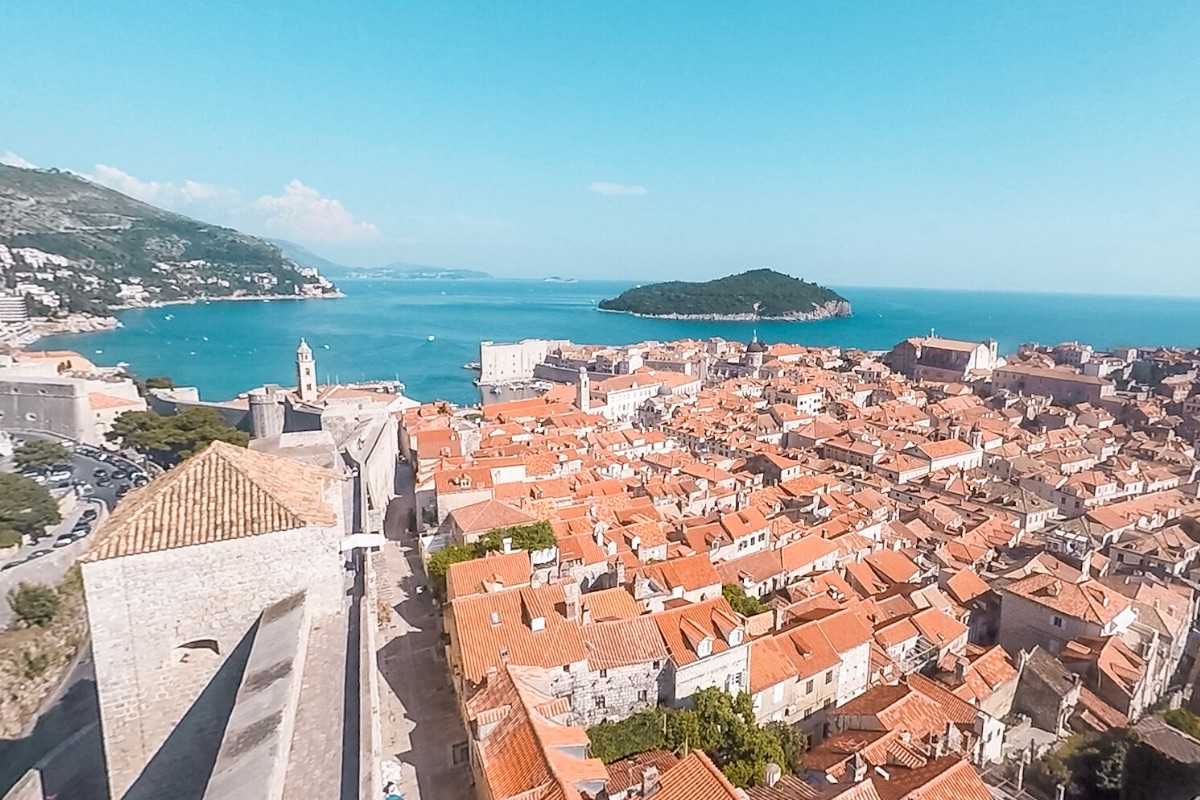
Plitvice Lakes National Park is perhaps one of the most unique and visually stunning places on earth, and certainly one of the most intriguing UNESCO World Heritage Sites in Europe. The park is full of hundreds of waterfalls and cascading lakes with clear mountain water. Many trails in the park lead to stunning overlooks, and there is a network of boardwalks that go over the water!
Trogir is a Croatian coastal city that is a must-see for a few reasons. First off, there are over 1,000 islands off this coast. Furthermore, there are many tours from Trogir that hop from island to island. On top of that, the seafood in this town is so fresh and delicious you will not believe it. Finally, the people in Trogir are so darn friendly that you will feel right at home! Maybe you won’t want to leave…
On the southern tip of Croatia is the walled city of Dubrovnik. Old Town Dubrovnik, known in popular culture as King’s Landing in Game of Thrones, is perhaps the most famous site in Croatia, and for a good reason. Dubrovnik is full of walking tours that share the vivid and storied past of this city. The walls have still never been conquered in an attack even once! And they have been attacked consistently since the wall was built in the 13th century! Take a tour of Old Town Dubrovnik and walk the walls and see how impressive they are for yourself!
All in all, Croatia is a must-visit country, one of the most underrated countries in Europe. Plitvice Lakes National Park, Trogir, and Old Town Dubrovnik are three incredible UNESCO World Heritage Sites that will make your trip unforgettable.
Kotor, Montenegro
by Nick Kembel, Spiritual Travels
The Old Town (Stari Grad) of Kotor in the Balkan nation of Montenegro is a walled medieval city that is about as charming as it gets. The town occupies a strategic position on the visually magnificent Bay of Kotor and thus has been conquered by a long list of foreign forces going back to Roman times.
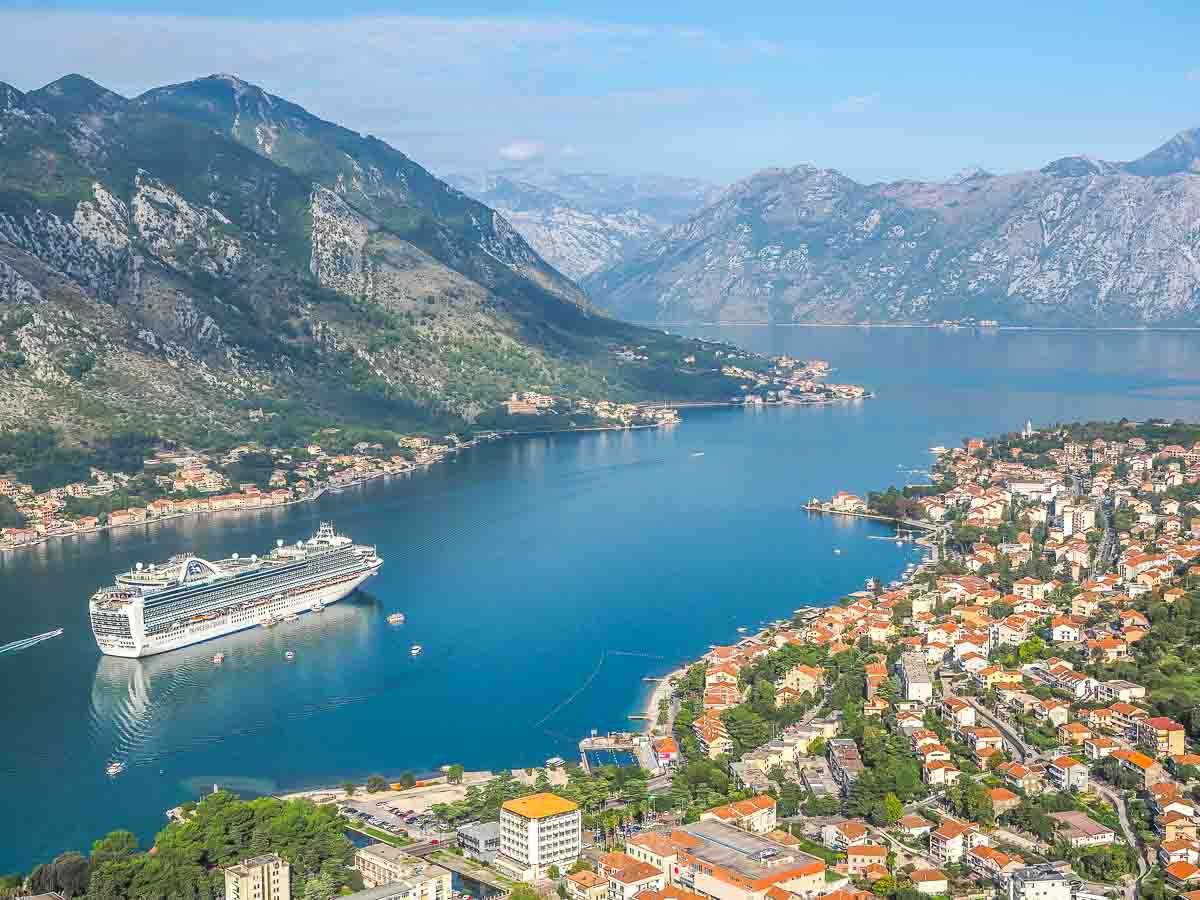
Composed of glistening cobblestone pedestrian lanes and a high concentration of churches, Stari Grad is small enough that you can cover all of it in a few hours. Still, getting lost once or twice in the maze of alleyways is practically inevitable. All roads seem to eventually lead to the mighty Cathedral of St. Tryphon, which dates to 1166 but has been rebuilt several times after major earthquakes.
No visit to Kotor is complete without hiking up to Saint John’s Fortress. The 1.5-hour return trail follows a portion of the Old City wall that snakes up the mountain backing the town. From the fortress ruins, visitors enjoy an unparalleled view over the Bay of Kotor.
The finishing touch is Kotor’s reasonably priced local cuisine (think great seafood, pizza, cheese, wine, and beer) served on tables set up in atmospheric lanes and plazas. Cat lovers should note that the town is swamped with felines, and there’s even a museum dedicated to them.
Kotor is not the undiscovered Adriatic gem it once was. Daily cruise ships unload thousands of passengers in the old town, clogging its streets. However, it’s still not as bad as more popular Dubrovnik a few hours north along the coast in Croatia.
To beat the worst crowds but still enjoy good weather, come in the shoulder season (May-June or September-October). Be sure to spend the night, and you may find the streets pleasantly crowd-free after the day-trippers leave.
Meteora, Greece
by Stephanie Craig, Sofia Adventures
One of the most majestic UNESCO World Heritage Sites in Europe that I have had the privilege of seeing in person is Meteora, the collection of medieval Greek Orthodox Monasteries perched high atop rock columns. Dating back to as early as the eleventh century, the monasteries are true marvels of architecture, engineering, and artistic achievements. It’s almost impossible to believe that these feats were even possible with the technology available at the time they were built.
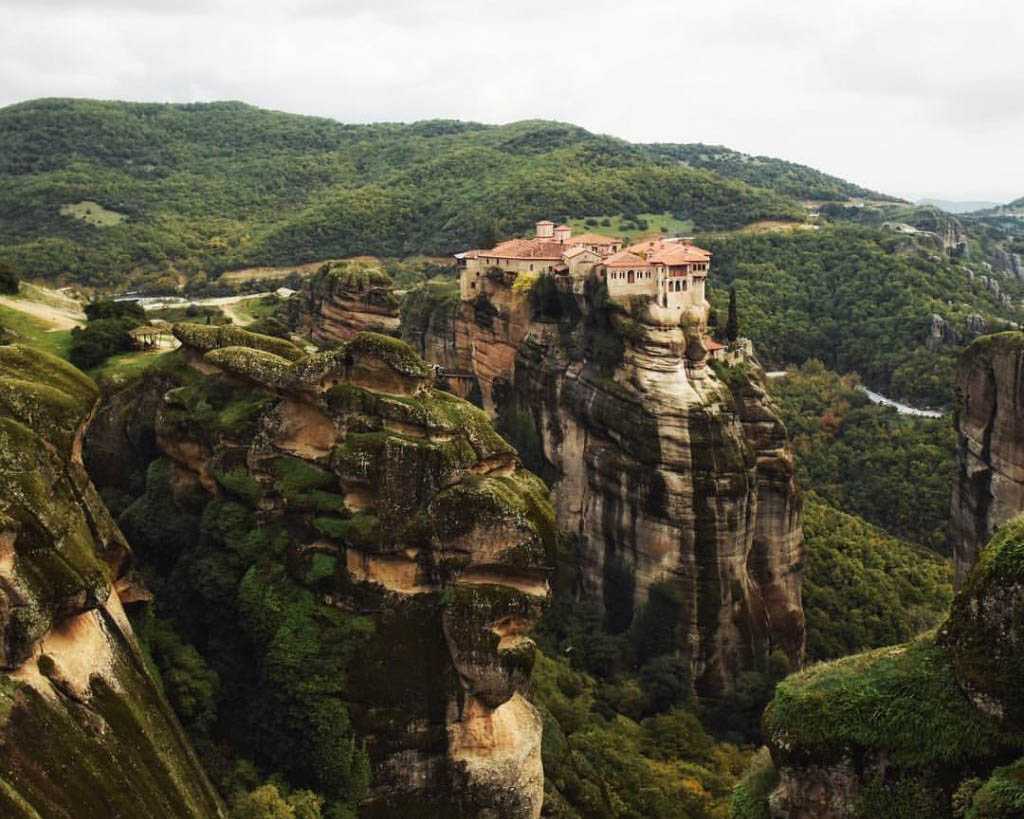
Highlights include stops at the Monasteries of the Great Meteoron and St. Stephen while seeing the Monasteries of Varlaam, and Roussenou from afar was one of my favourite things about visiting the site. You can tour Meteora from Athens or Thessaloniki as a day trip (though it’s a very long day!). Alternatively, you can stay in the nearby town of Kalambaka for a few days and see the area at a slower pace. This is the best option for anyone looking to hike in the area. Guided tours do not have time for additional hikes if you also need to spend hours coming in from the cities by train or bus.
UNESCO World Heritage Sites in Scandinavia
Geirangerfjord, Norway.
by Sam Weatherley, Memories and Mayhem.
Geirangerfjord is one of Norway’s most popular tourist sites. UNESCO declared it a World Heritage Site in 2005, and it’s easy to see why. With its sparkling blue water, Geirangerfjord has an almost magical feel. It’s no wonder Disney got inspiration for Frozen from the Fjord. So, get ready to discover more about this fantastic UNESCO World Heritage Site in Europe.
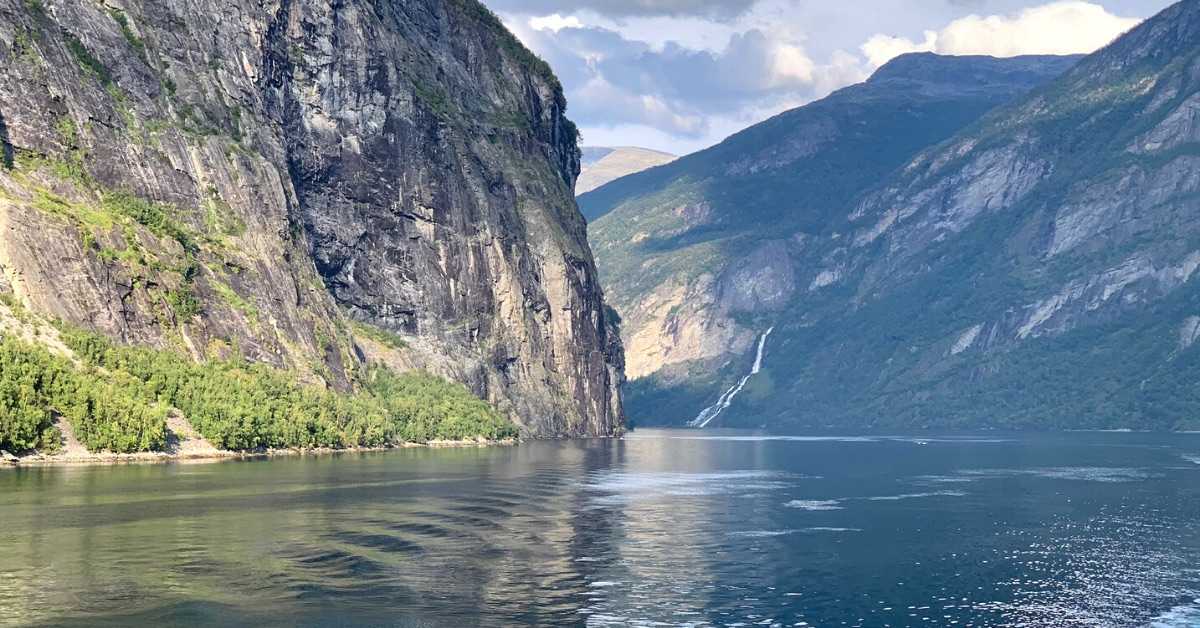
Bordered on both sides by huge mountains that seem to float on the water, the best way to view the Fjord is by boat. Sailing up the Fjord gives visitors the best views of the two famous waterfalls. The Seven Sisters waterfall and the Suitor waterfall face each other. Folklore says that the Suitor is trying to woo the Sisters. A little further up the Fjord is Bridal Veil, named for the way the waterfalls over the rocks behind it.
The small town of Geiranger sits at the end of the Geirangerfjord, where the Geirangelva river empties into the Fjord. Although the town is small, there is plenty to do on a day trip.
Visitors will enjoy the small shopping area. With traditional shops, cafés, and a bakery, you’ll get a lovely taste of Norway. For those who enjoy a little exercise, the Waterfall Walk takes visitors up 300+ steps and offers beautiful views of the Fjord.
To experience even more spectacular views head to the Geiranger Skywalk. Situated 1500m above sea-level, the mountain air will invigorate you as you take in the scenery.
This beautiful area really demonstrates why Geirangerfjord is the jewel of Norway. Adrenaline junkies can take advantage of helicopter tours or hire little electric cars to zip around the winding mountain roads. And of course, the best way to maximize those views is to take a boat trip. There are many on offer in the town, with everything from gentle tour boats to the superfast rib boats.
However you choose to spend your time, you won’t be disappointed with a visit to Geirangerfjord.
Kronborg Castle, Denmark
by Derek Hartman, Everything Copenhagen
One of Denmark’s most beautiful UNESCO World Heritage Sites lies 40 minutes north of Copenhagen. Kronborg Castle sits at a strategic waterway between Denmark and Sweden where the North Sea and the Baltic meet. Control of that waterway, known as The Sound, has been a source of wealth for Denmark over the centuries. At the time Kronborg was built, Denmark held most of the lands in Southern Sweden. This fortified palace enabled Denmark to collect a Sound Fee from every ship entering the Baltic Sea.
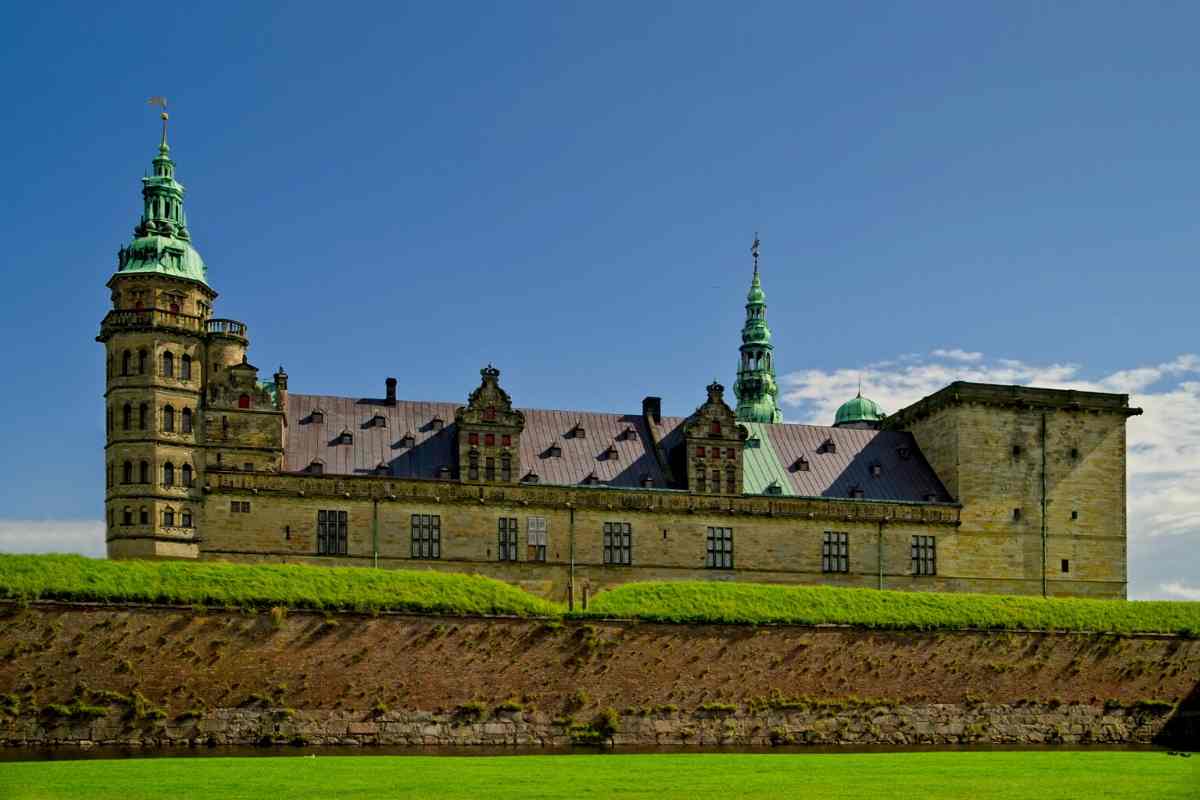
Inside the well-preserved castle, you can tour the Royal Apartments of King Frederik II and his loving wife, Queen Sofie. The opulent Grand Ballroom was the largest in Northern Europe at the time of Kronborg’s construction. Visitors also enjoy exploring the subterranean level of Kronborg where castle staff lived, and prisoners were held. The ramparts, cannons, gun towers, and barracks are also available to visitors. The pristine chapel at Kronborg Castle is breathtaking and a must-see attraction at Kronborg. Guided tours of Kronborg are held daily, and they are included in entrance fees.
This remnant of Denmark’s Golden Age has an even more interesting history, and it comes from literature. Kronborg Castle is the setting for one of Shakespeare’s most famous plays, Hamlet. Most people are familiar with the famous line, “There’s something rotten in the state of Denmark.” The setting was likely inspired when a London acting troupe, of which Shakespeare was a member, visited Kronborg Castle. It’s unclear if Shakespeare himself visited the castle, but he offered a very detailed description of the grounds.
Whether you’re retracing Hamlet or Danish military and commercial history, Kronborg is a fascinating destination and a beautiful UNESCO World Heritage Site.
Suomenlinna Sea Fortress, Finland
by Piritta Paija, Bizarre Globe Hopper
Suomenlinna Sea Fortress is a unique place that stands in front of Helsinki in the Gulf of Finland as the last line of defense of the capital city of Finland. The building of this island sea fortress made of stone began already in the mid-18th century. During its time, it has served in defense of three different realms, Russia, Sweden, and Finland.
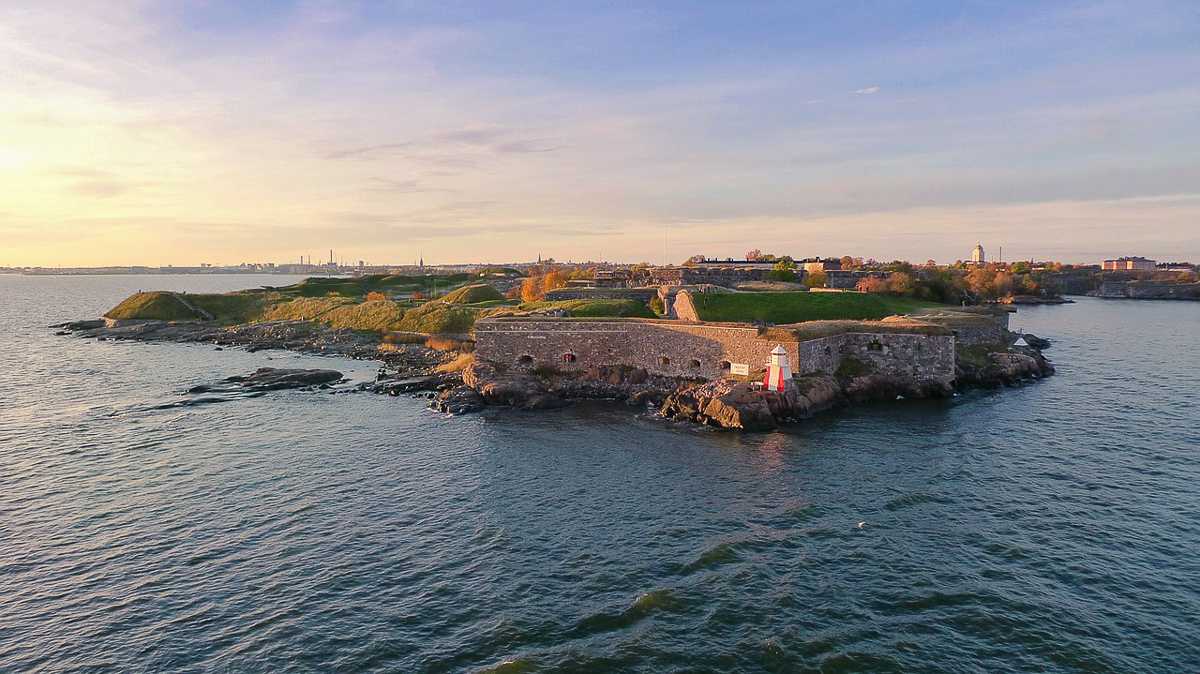
Suomenlinna was added to the Unesco World Heritage list in 1991. Today, this unique monument of military architecture is a place where the locals go for day trips in summer or winter alike to spend a memorable day in the middle of history. There are several museums where you can get to know the past of Suomenlinna/Sveaborg. Or you can just spend your day strolling around the walls and bastions all over the island. Or you can have an adventure walking in some of the tunnels dug in the earth.
At Christmas, a lot of Christmas-themed happenings are arranged in the area. In the summertime, Suomenlinna is a popular place to go and have a picnic or a refreshing swim in the sea.
Nowadays, there are also a small number of people living permanently in Suomenlinna. Still, mostly this charming, little fortress island is inhabited by day visitors of all ages. Suomenlinna is definitely a must-see place when you’re visiting Helsinki, especially during Christmas time, it’s one-of-a-kind with a unique atmosphere.
You can get to Suomenlinna by a ferry from Kauppatori in Helsinki, and it takes only about 15 minutes. The boat runs every day from Monday to Sunday and also on most of the public holidays. There are public ferries as well as private companies’ ferries. However, I’d recommend just to take the public ferry. They are much cheaper, and they run more frequently.
UNESCO World Heritage Sites in Europe: the British Isles
The Giant’s Causeway, Northern Ireland
by Sinead Camplin, Map Made Memories
The Giant’s Causeway is situated on the beautiful north coast of County Antrim in Northern Ireland. The iconic geometric rocks and towering basalt columns of the Giant’s Causeway are world famous. The Causeway consists of three short promontories stretching into the sea, centred in one location within a dramatic and scenic section of coastline. An estimated 40,000 lava formed rocks slope downwards, eventually disappearing into the turbulent Irish sea. It is easy to see how the legend of the Causeway as a pathway for giants came to be. It is a short paved walk from the Visitors Centre to the Causeway itself, or alternatively, you can catch a small, fee-paying electric bus. There are two trails to explore the Causeway Coast, and you are permitted to walk and climb on the rocks – though be wary of the uneven ground. Plus, signs and lifebuoys hint at the danger of getting too close to the crashing waves.
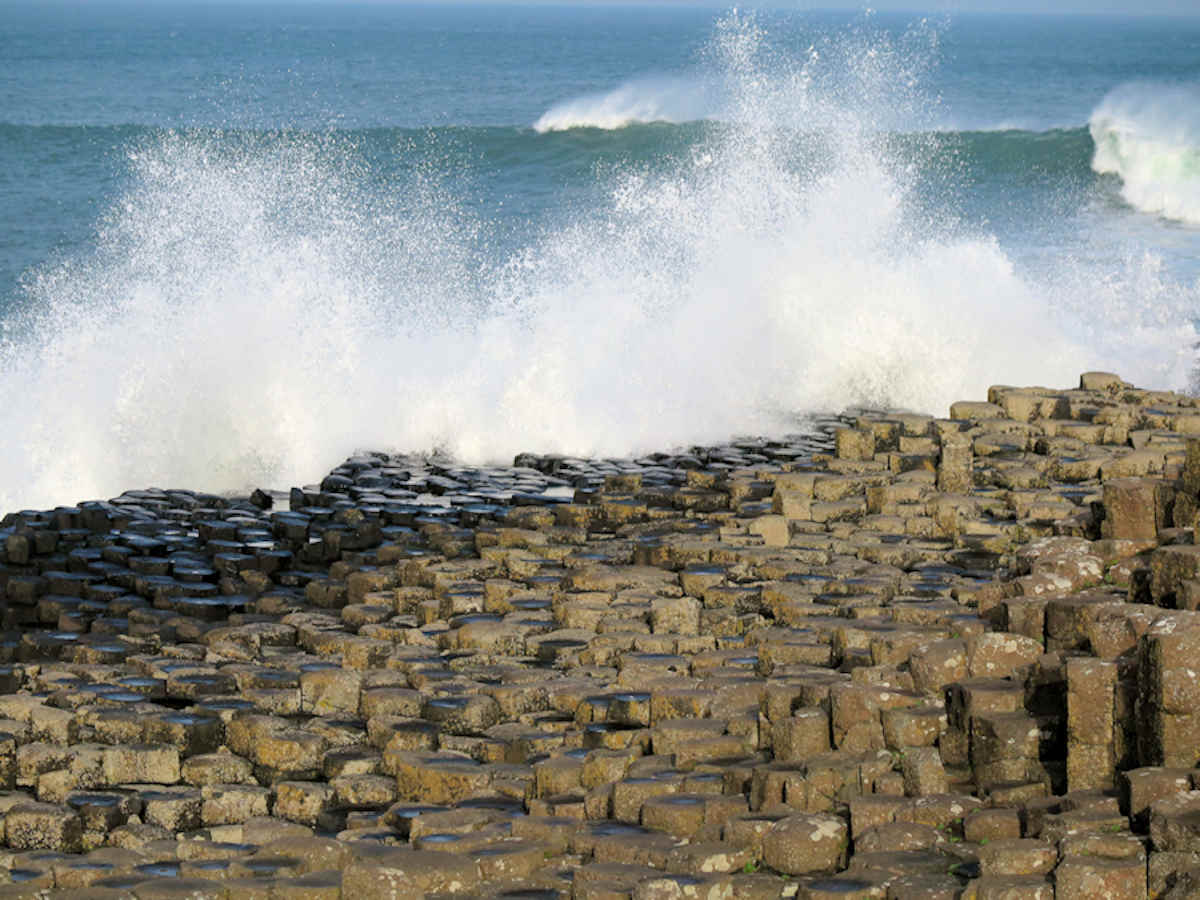
The two trails are of differing length and wind around the Causeway Coast. Along them, you can take in the best views and interesting sights such as the impressive Organ Pipes and the huge rock which is aptly named ‘The Giant’s Boot.’ I would recommend walking the longer Red Route which leads to a viewpoint towards The Giants Chimneys (a 100-metre high tower of rock). You’ll have the chance to get close to the unusual red layered laterite rock that forms these Antrim cliffs. There is a fee-paying, grass-roofed Visitors Centre at the car park with interesting exhibits about the formation of the Causeway. Still, you do not have to pay to access the Causeway itself. The Giants Causeway is a stunning and atmospheric UNESCO site to visit.
The Giant’s Causeway and the surrounding area are simply breathtaking and well worth spending a few days. However, in case you have limited time, you can also visit what I consider one of the most unique UNESCO World Heritage Sites in Europe on a day trip from Dublin. I recommend the tour to the Giant’s Causeway and Carrick-a-Rede bridge (another incredibly scenic stretch of coast). And if you’re a fan of Game of Thrones, have a look at the day trip which will lead you to the Giant’s Causeway as well as through some of the iconic locations of the popular TV Series.
King Edward the 1st Castles, Wales
by Bec Wyld, Wyld Family Travel
Although Edward the 1st built many castles in Wales, there are only 4 that make up the UNESCO World Heritage Site. They’re Beaumaris Castle, Harlech Castle, Conwy Castle, and Caernarfon Castle.
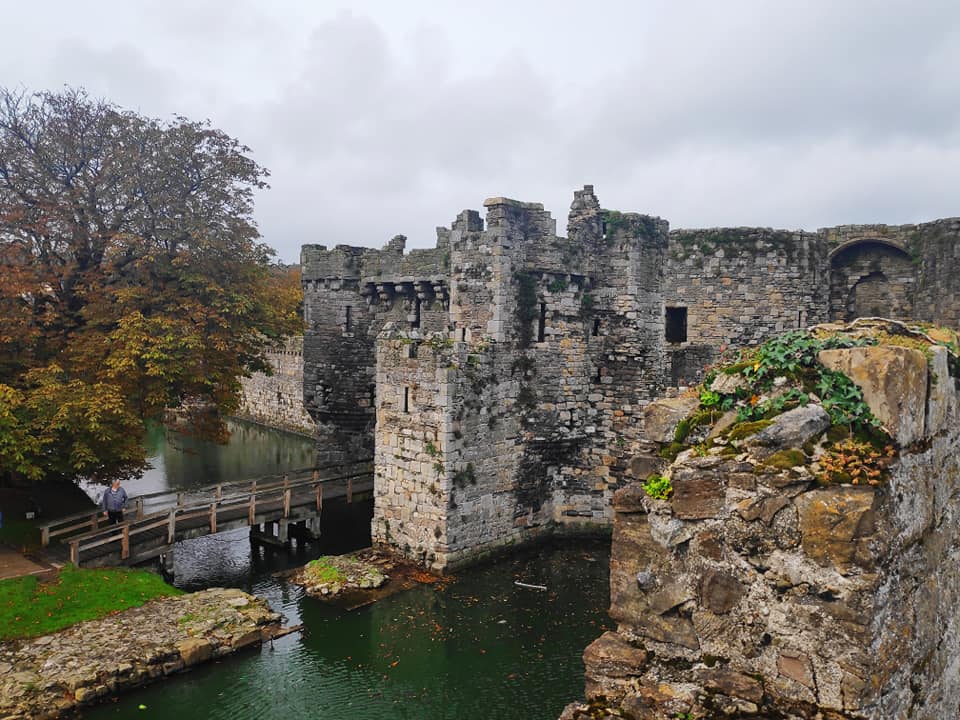
After he defeated the Welsh Prince in 1282, Edward the 1st set about claiming his dominance in the area, believing it would prevent the Welsh from rising against him. While it was mainly true, the Welsh did rise against him on a few more occasions.
These 4 beautiful castles were included in the UNESCO fold as “finest examples of late 13th century and early 14th century military architecture in Europe”. Oddly, it is unknown why the rest of the castles he built in the area were not included.
The castles are all very different. Still, they are all similar in the fact that they were built to impress and terrify those wanting to invade from home and abroad. Their positions at headlands or high on a peak overlooking what must have seemed like the entire earth made them formidable to anyone.
Caernarfon is probably the most well known as it is where the title of ‘Prince of Wales’ comes from. It’s also where Prince Charles was given the title by his mother, Queen Elizabeth.
While the castles are mainly ruins, there is so much you can learn from them with rooms painstakingly repaired to make sure that the history of these buildings is not completely lost. For the ones that have not been able to dedicate rooms to information, there is some outside. You will find this at all of the castles that Edward built not only the 4 in the UNESCO bundle.
The castles are magnificent to see and to walk around. They are hundreds of years old, have stood the test of time, and they’re still as intimidating and imposing on the Welsh landscape as if they were brand new.
UNESCO World Heritage Sites in Central Europe
Jungfrau-Aletsch Region, Switzerland
by Lucy Dodsworth, On the Luce travel blog
A land of snowy peaks, twisting glaciers, mountain meadows and wooden chalets, Swiss Alps (Jungfrau-Aletsch region) was the first Alpine UNESCO World Heritage Site, recognised as one of Europe’s most spectacular mountain landscapes. Located in southern Switzerland, the site is centred around the giant rock massif of the Eiger, Mönch and Jungfrau mountains and is home to the Aletsch Glacier, the longest in Europe.
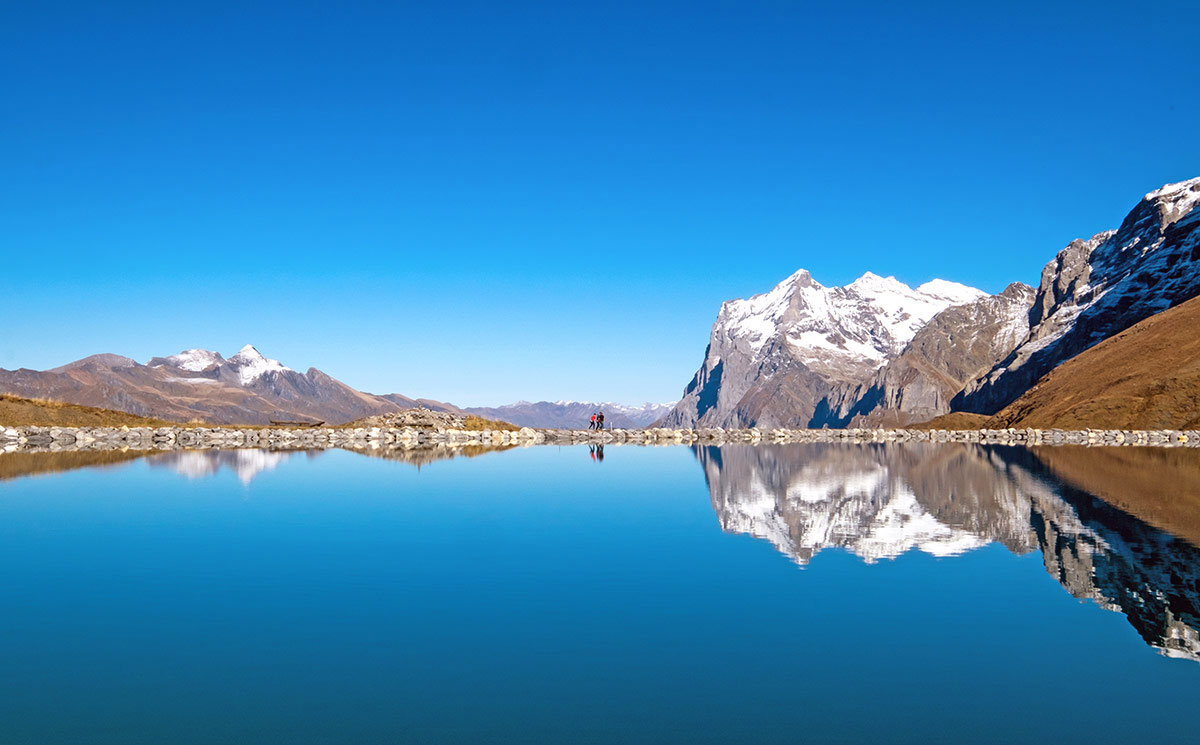
This is a land of extremes, with some of the best climbing and hiking around – from easy walks through the mountains above Schynige Platte to the extremes of the North Face of the Eiger. But you don’t need to be super-fit to explore the Swiss Alps – a network of cable cars and mountain railways make the region’s beautiful scenery accessible to everyone.
For the most beautiful views around, ride the train to Jungfraujoch Top of Europe. Leaving the mountain meadows of Grindelwald or Lauterbrunnen behind, it travels to Kleine Scheidegg at the base of the Eiger before tunnelling right through the mountain – an impressive engineering feat which took 16 years to build. At 3454 metres above sea level, the viewpoint at the top will take your breath away, as will the views across the Aletsch Glacier, with a sea of white opening up in front of you. Wrap up warm though as it’s always winter up at the top.
You can also get up close to the Aletsch Glacier via the gondolas from either Bettmeralp or Eggishorn. Or try out something more extreme at Grindelwald First. In winter the area is a ski resort with 49km of slopes to explore. But in the summer you can try out adrenaline-fuelled activities like the zip wire, glider or the cliff walk, with metal walkways bolted into the side of steep mountain cliffs.
Carcassonne, France
by Elisa, France Bucket List
The fortified citadel of Carcassonne is one of the most beautiful UNESCO World Heritage in France. It is famous for the château of the Counts of Carcassonne and its 3 kilometres of ramparts, from where visitors can enjoy magnificent views.
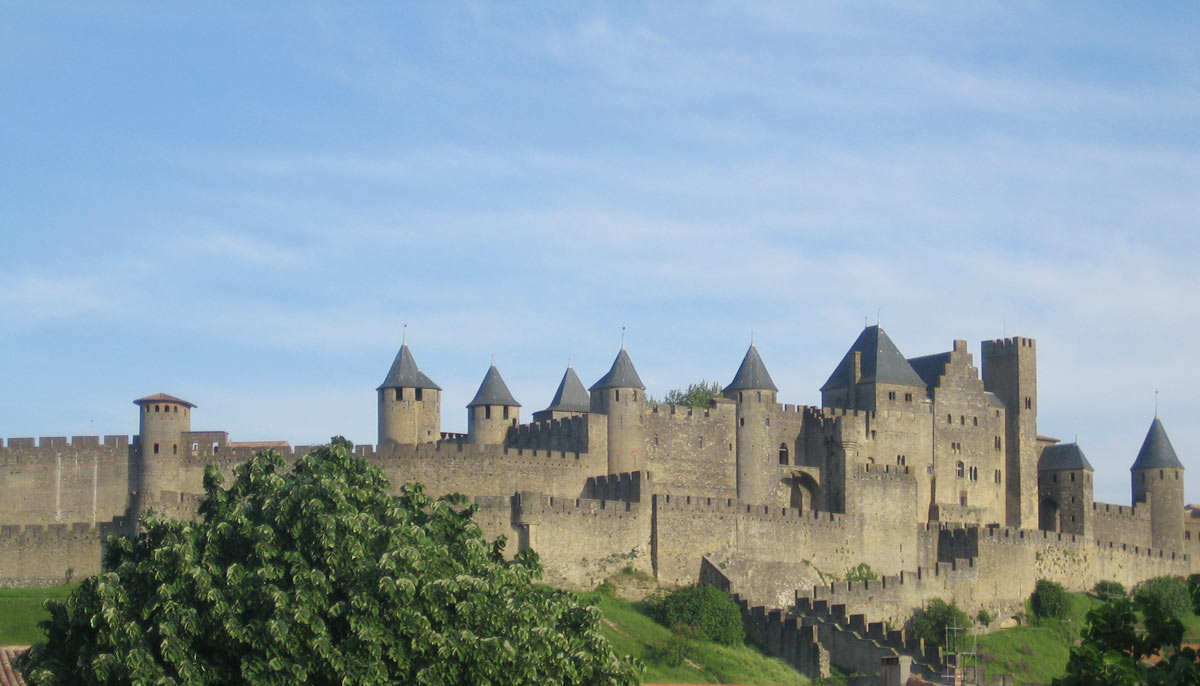
Carcassonne is located in southern France, in the French region of Occitanie. Today the citadel is part of the Cathar Route, a tourist circuit that includes 22 exceptional sites related to the Cathars.
Catharism was a dualist religion that flourished in the Languedoc during the XII and XIV centuries. The Cathars combined a tradition of itinerant preachers in the forests with a very ascetic quality and rejected the Roman Catholic and the entire church structure. The Catholic Church declared the Cathars heretics and called a crusade to destroy them.
Carcassonne was the centre of power of the Counts of Carcassonne and later, in the XII century, of the famous Family Trencavel. It was under the Trencavel’s rule that Carcassonne was accused of complicity with the Cathars. As a consequence, during the Albigensian Crusade (1209-1229) initiated by Pope Innocent III, the citadel was besieged and fell under royal ownership in 1226. The city subsequently became a royal stronghold protected by a double outer wall that defended the border between France and Aragon until the Treaty of the Pyrenees in 1659.
In the XIX century, Carcassonne was in a state of abandonment, and the architect Viollet-le-Duc restored the fortified citadel and gave it back its medieval appearance. It was a pity that he used grey roofing stone for the towers, which is only common in fortresses and castles of northern France but never in these latitudes. However, Carcassonne remains a beautiful place to visit in France and a key site to understand the terrible history of the Cathars.
The Historical Centre of Avignon, France
by Nadine, Le Long Weekend
When visiting Provence, a visit to Avignon is absolutely essential. It’s here you’ll be introduced to the rich and intriguing history of the region through the outstanding historical monuments that pepper the city. The old town of Avignon is one of the most beautiful UNESCO World Heritage Sites in Europe, and there are a few key points of interest you must delve into in more detail.
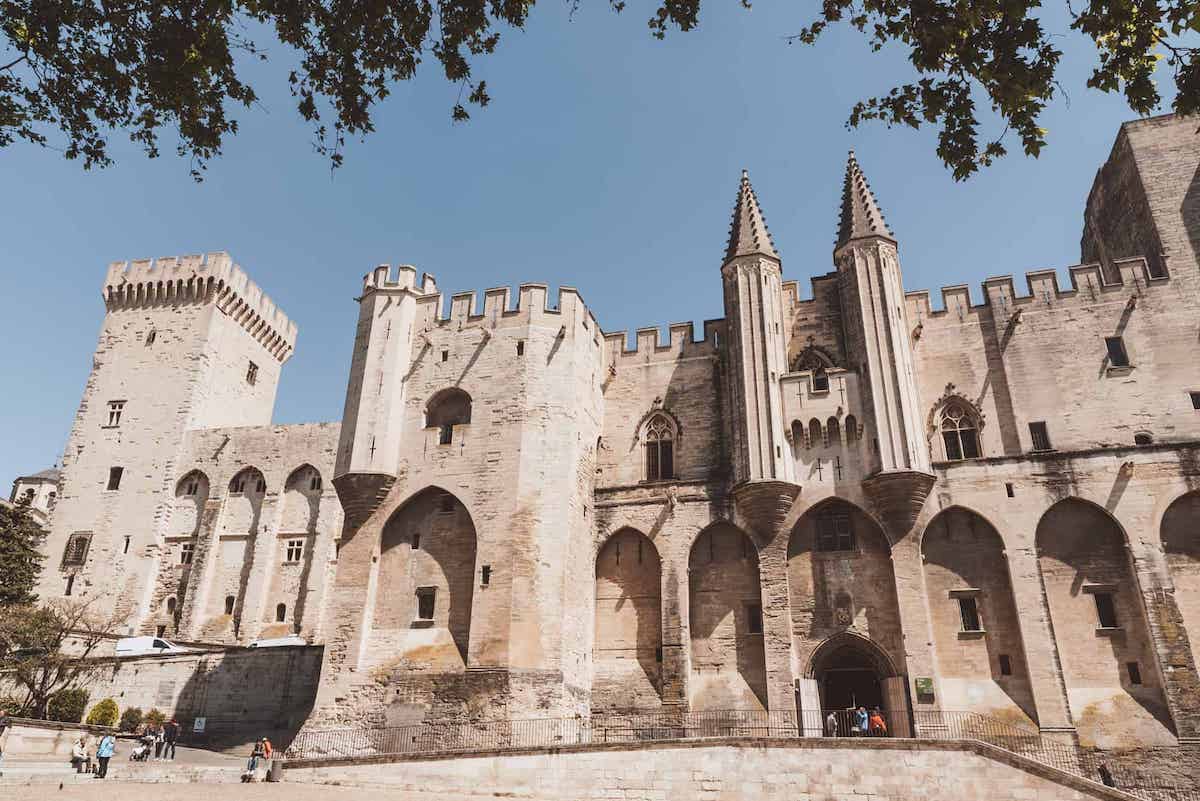
Most prominently, there is the Palais des Papes that rises high above the terracotta rooftops of the town, unmistakable in its grandeur. A tour inside is crucial, and the accompanying Histopad will transport you back in time to when the empty halls were bustling with life and the day-to-day happenings of the palace. Just a quick walk away is another iconic attraction.
The famous Pont d’Avignon now only partially spans the width of the Rhône River, but it is a striking sight nonetheless. Buy a ticket (it’s cheaper if you buy a combined ticket with the Palais des Papes) to walk its length and visit the petite chapel at the halfway point. Finally, a quick walk up to the raised Rocher des Doms will help you get your bearings as you take in the Palace, the Pont, and further afield over the île de la Barthelasse, to the Fort Saint-André in the distance. Once you’ve ticked those off your list, you can wander the old cobbled streets, visit one of the many museums and galleries concentrated in the old town, and marvel at the grand architecture & medieval remnants on display all around you.
Upper Middle Rhine Valley, Germany
by James Ian, Travel Collecting
The Upper Middle Rhine Valley in Germany is not only a UNESCO World Heritage Site, but it is also one of the most beautiful places in Europe. The 65-kilometre stretch of the Rhine River between Koblenz and Rüdesheim is dotted with about 40 castles, cute villages, green forests and steep vineyards.
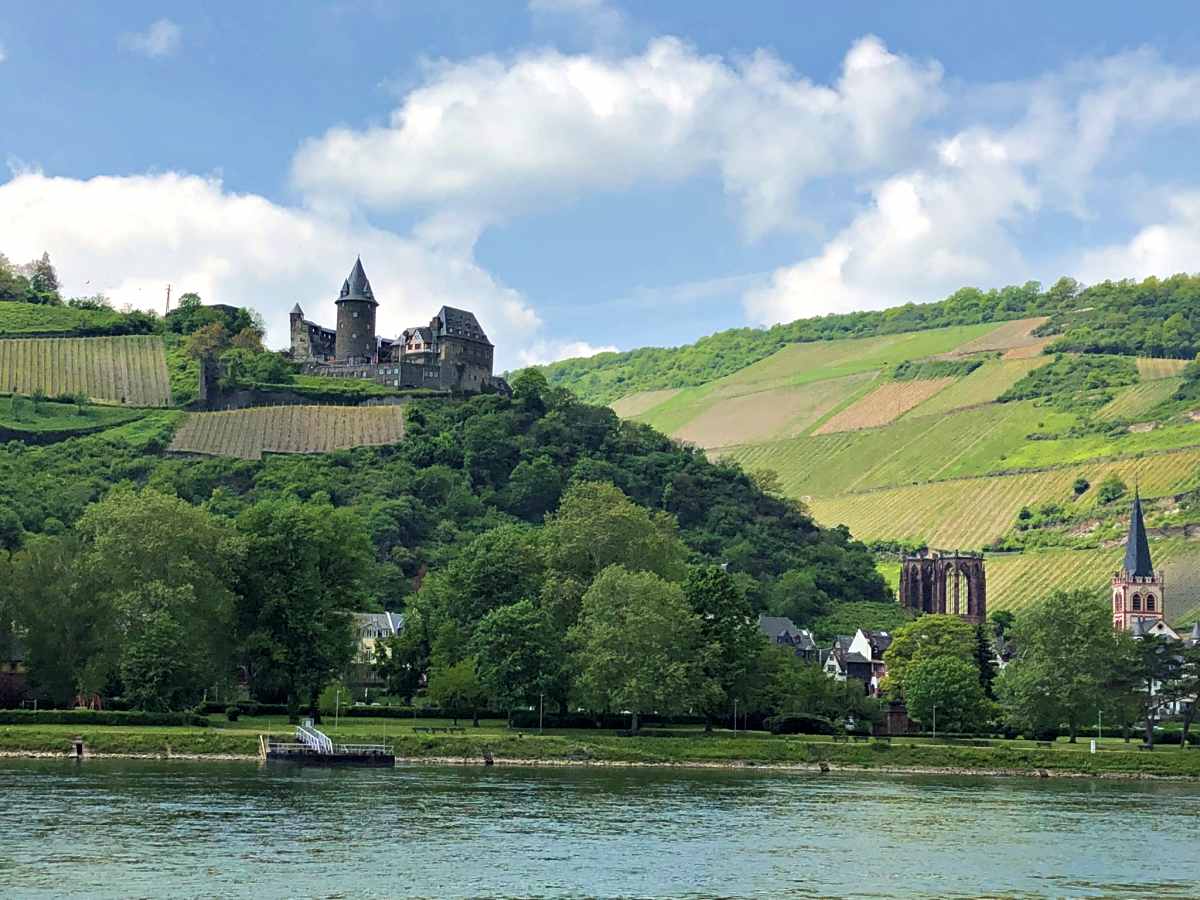
The best way to see them all is on a boat cruise through the Rhine River Valley. Boats are leaving several times a day, and you can cruise nonstop in about six hours or get off and stay overnight on one of the delightful villages along the way. The trip starts in Koblenz at one end, or Rüdesheim or nearby Bingen at the other (train connections to Frankfurt are better from Bingen than Rüdesheim).
Highlights include Rheinstein Castle, perched atop a craggy outcrop; the nearby sprawling Reichenstein Castle; the picturesque village of Bacharach backed by the turreted Stahlek Castle on a nearby hill and surrounded by vineyards; and Marksburg Castle behind Braubac. Villages that are worth stopping off at include Boppard and Oberwesel. There, you can explore tiny streets and buildings covered in crisscrossed patterns of coloured wood on pale walls. Stop off for a beer or a glass of wine from one of the many wineries in this region.
Perhaps the most famous castle of all is Pfalzgrafenstein Castle. This tiny castle is on an island in the middle of the river; a small white castle with a black roof and an orange prow, shaped like a ship at one end. Rising on the vineyard-covered hills behind it is romantic Gutenfels Castle.
This entire stretch of the Upper Middle Rhine River is one incredibly beautiful scene after another.
St. Nikolai Church in Stralsund, Germany
by Monika Fuchs
The old town of the city of Stralsund on the Baltic Sea in northern Germany is a UNESCO world heritage. The reason is the medieval setup of the town, which is almost entirely preserved. St. Nikolai Church at the Old Market together with the medieval town hall in their brick gothic style dominate the old centre of town.
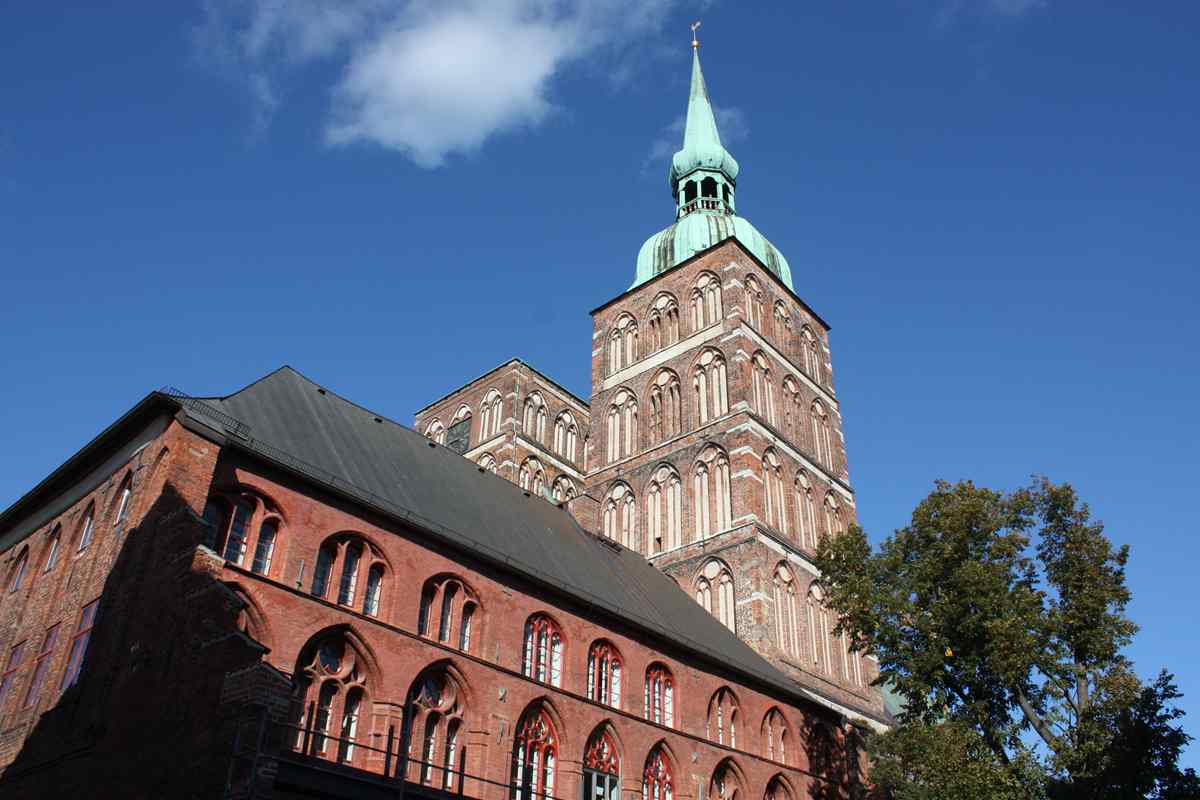
St. Nikolai Church and its interior impressed me most. Upon entering the church, I was awed by the colors, that cover the columns, the walls and the pulpit. Even the wooden pews are painted and tell stories about the lives of the people in the times when the church was built. It was a time when most inhabitants were illiterate. Thus paintings like these were a way to tell them stories – be it events from the bible or everyday life like the hunting scenes, we discovered on some of the pews.
Among the many treasures of the church are two, I want to mention here. One is the sculpture of Anna Selbtritt, who was the patroness of dressmakers, shopkeepers and skippers. The statue dates back to the time when the church was built around 1270. Another highlight of the church is the Astronomical Clock, which is a bit hard to find. You can see it on the back wall of the altar. It not only shows the time of day but also the location of the stars in the universe.
A visit to this church is like a trip back in time. You learn a lot about life in the Middle Ages, just by looking at the artwork, you find in every nook and cranny of St. Nikolai Church.
Potsdam, Germany
by Nicole La Barge, American SW Obsessed
Potsdam is a Unesco World Heritage Site in Europe known for its Grand Palaces, beautiful gardens, including a rose garden, and Roman baths. It is located 16 miles outside of Berlin and is the capital of Brandenburg.
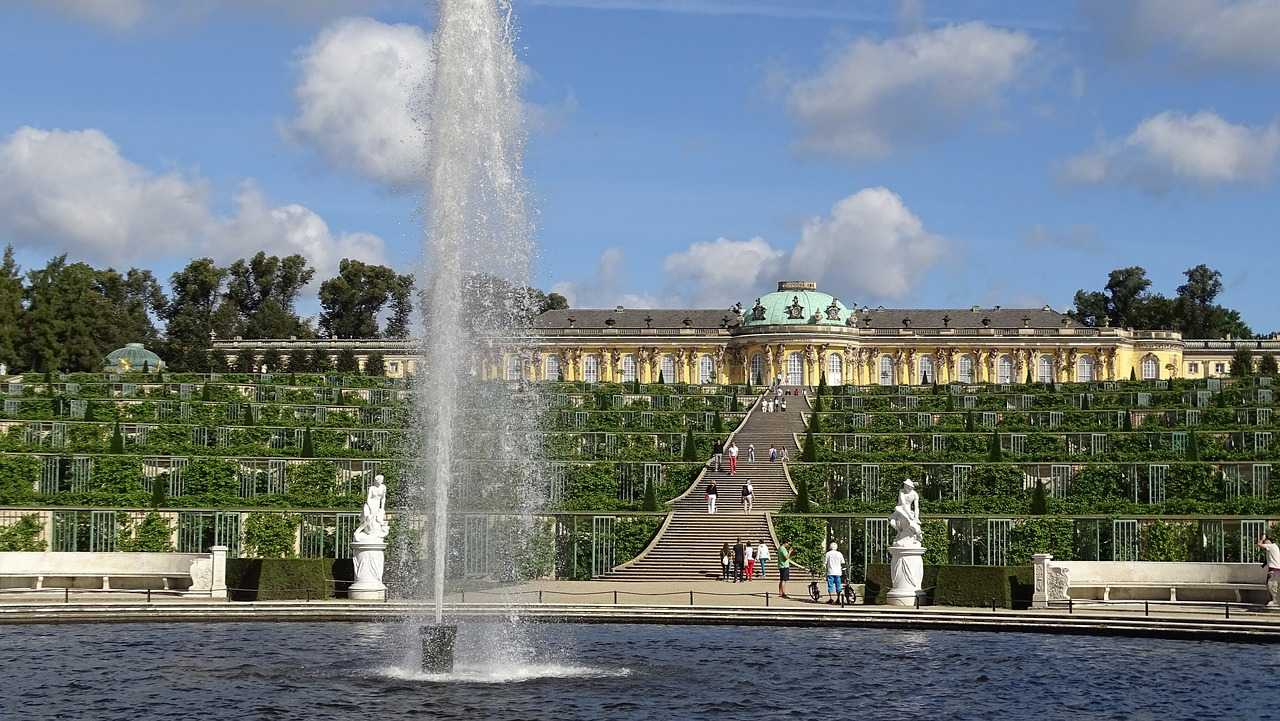
One site you must see is Potsdam’s impressive Sanssouci Palace. This German Palace is the Versailles of Germany and is known for its baroque architecture and excessiveness.
In contrast to the Sanssouci Palace is the Neues Palais which was built by Federick the Great after the Seven Year War with France. This palace is built in the Baroque architecture and has an impressive 200 rooms.
The last site to see in Potsdam is the Brandenburg Gate – not to be confused with the Brandenburg Gate in Berlin. This Neoclassical gate was built 20 years before the one in Berlin.
No matter where you go, in Potsdam you are sure to see beautiful buildings, history and gorgeous gardens.
Bruges, Belgium
by Tom Stevenson, The Travelling Tom
The historic centre of Bruges is simply magnificent. The cobbled streets, beautiful brick buildings and meandering canals combine to create a setting that reminds of a fairytale. Indeed, the historic centre is so beautiful, it was used as the main location of the popular film In Bruges!
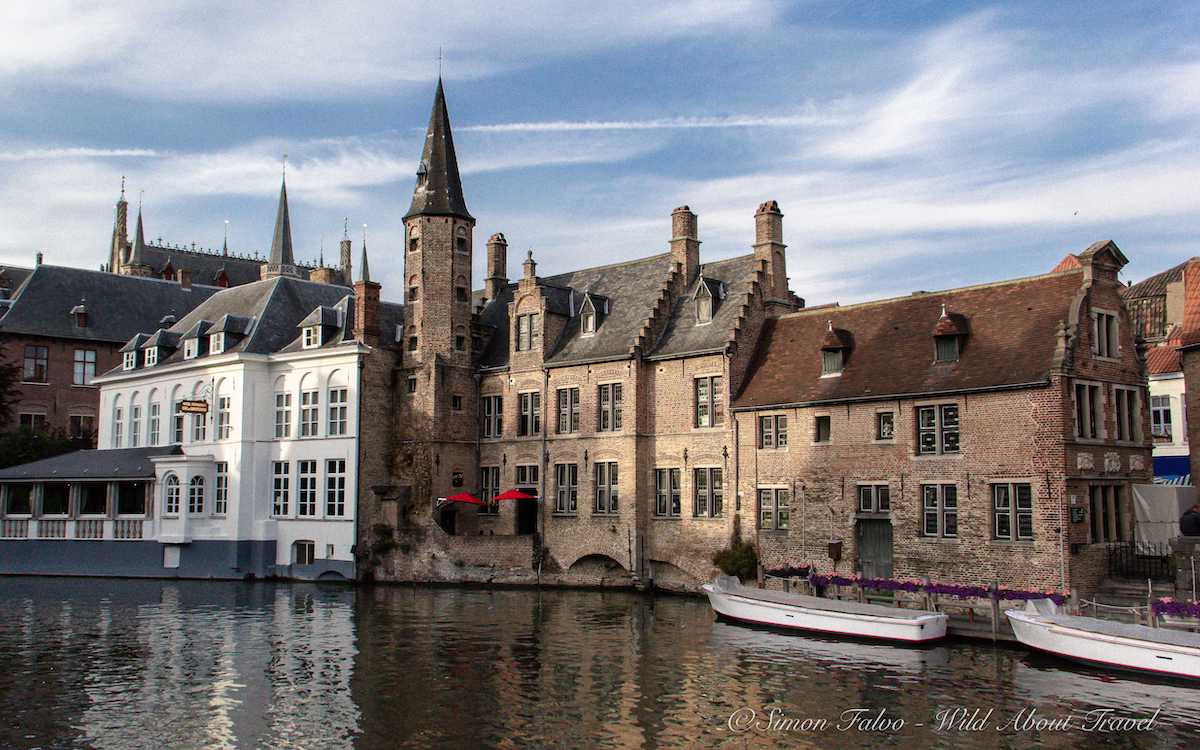
The best thing about Bruges is its architecture. The belfry is a particular highlight. It towers into the sky and can be seen from across the city. You can climb up it to get great views of the historic centre and beyond. A boat along the canal is one of the best ways to see the centre. You will get to see the centre up close and from a different perspective.
As beautiful as Bruges is during the day, it’s even more beautiful at night. A wander around the centre at night is something you have to do during a visit to Bruges! The views are breathtaking and reinforce the feeling of being in a fairytale!
Amsterdam Canals, the Netherlands
by Frankie Thomson, As the Bird Flies
As a long-term Amsterdam resident, it’s hard to believe that UNESCO only named the city’s historic canal network a World Heritage Site in 2010. Still, it’s certainly one of the most famous European sites on the list. While just admiring its well preserved beauty is the main reason people come to Amsterdam to visit this area, which UNESCO classifies as the canal ring area that is within the Singelgracht and therefore includes the numerous canals and bridges that make up the oldest part of Amsterdam, it’s not just the picture-perfect scenes that put the network on the list.
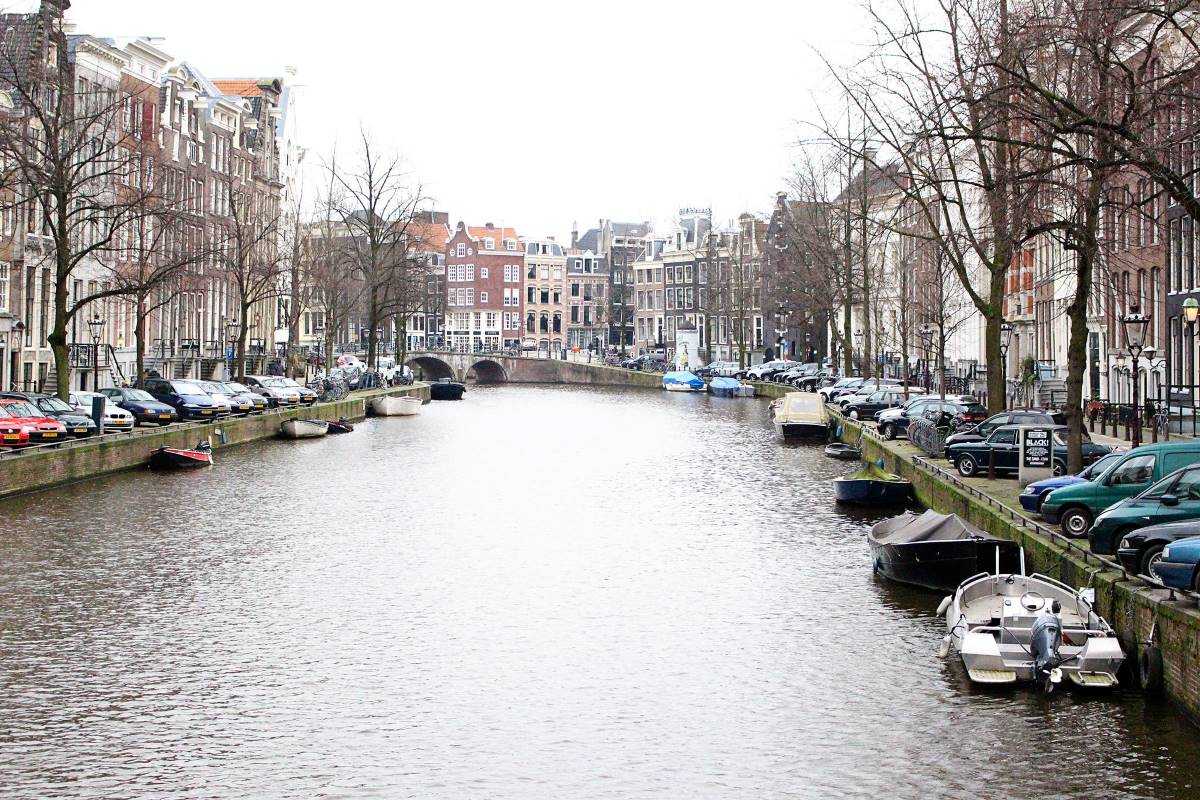
Quickly and efficiently designed and built during the Netherlands’ so-called Golden Age in the 16th and 17th centuries, Amsterdam’s inner canals are recognised as a UNESCO World Heritage Site because this example of systematic urban planning was somewhat ahead of its time and continued to be influential long into the 19th century.
The area also includes a number of Amsterdam’s most famous landmarks and houses. There are the obvious places like the floating flower market Bloemarkt, De Wallen (the Red Light District) and of course, there is Anne Frank House Museum in the building where Anne Frank and her family hid in their Secret Annex during the Second World War when Amsterdam was occupied by the Nazis. And then there are other things worth looking out for like one of the thinnest houses in Europe at Oude Hoogstraat 22, the cute shopping area of Negen Straatjes (9 Streets), and the historic site of Begijnhof – an inner courtyard lined by houses, including the oldest house still standing in Amsterdam, that have only ever been occupied by single women. Walking along Amsterdam’s most central canals is still one of my favourite free things to do in Amsterdam. So I can recommend to those who are looking for those beautiful photographs of Amsterdam’s canals that I think the best (and quietest!) canals for taking photos are Reguliersgracht (also known as Seven Bridges) and Brouwersgracht.
UNESCO World Heritage Sites in Eastern Europe
Kraków, Poland
by Rachael Gunn, Champagne on Arrival
For anybody who appreciates history or architecture, visiting Kraków in Poland should be high on your travel plans. The sheer number and density of superbly well preserved historic buildings through the ages is quite impressive, with a real blend of architecture from the Gothic, Baroque and Renaissance periods.

One of the first sites to feature on the UNESCO World Heritage list back in 1978, the Historic Centre of Kraków comprises of three main areas; the medieval city of Kraków, Wawel Hill, and the Jewish district of Kazimierz.
At the centre of it all is the Rynek Glowny, or Main Market Square, the creation of which signalled the official establishment of the city back in 1257. To this day, the Rynek Glowny remains the largest medieval square in Europe and is home to some of Kraków’s most impressive monuments.
From here, walk the Royal Route to Wawel Hill to experience the location where generations of the Polish monarchy lived, ruled and were finally laid to rest. It would take a couple of days to see everything here properly; from the numerous exhibitions in the Castle (including the former Royal Apartments) to the Cathedral and the crypts below it. Don’t miss the cave under the hill, which was rumoured to be home to the Wawel Dragon many years ago (and you may just find one still in there!).
The Jewish district of Kazimierz sits south-east of the main centre and is full of old synagogues and Jewish cemeteries to explore. Stay until after dark, and you will experience some of Kraków’s best nightlife in one of their many bohemian vibe bars.
The Church of Peace in Świdnica, Poland
by Marta Włodarska, Backpackers.Wro
Świdnica is a small town in Lower Silesia in southwestern Poland. On its territory is one of the greatest treasures of Poland – the Church of Peace. The Church of Peace was built under the agreements of the Treaty of Westphalia from 1648, which ended the Thirty Years’ War. The treaty allowed Protestants from Lower Silesia to erect a “church of peace” that would commemorate the end of the devastating war and the end of the religious conflict. The Church of Peace is on the UNESCO World Heritage List since 2001. The church is also the largest wooden baroque temple in Europe and one of the seven new wonders of Poland, according to “National Geographic.”
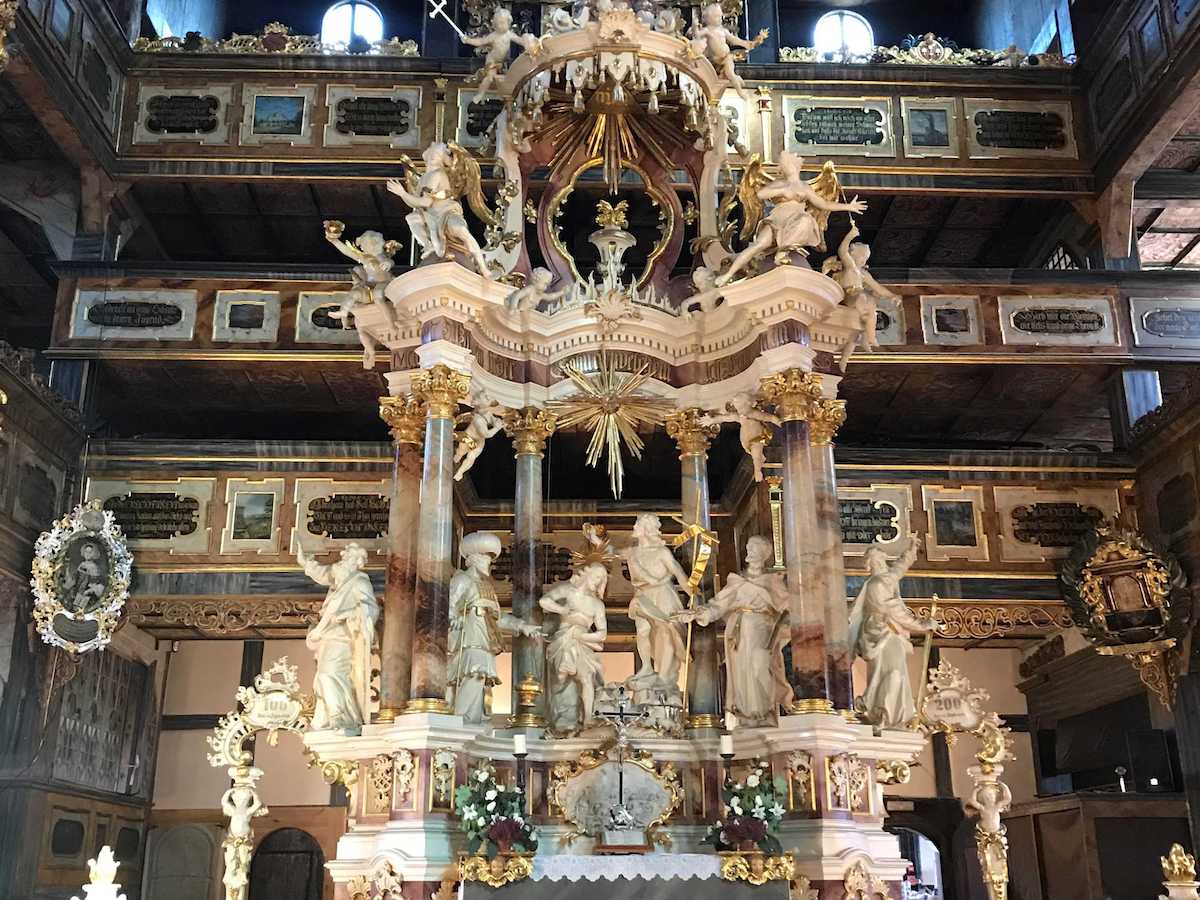
The Church of Peace is a place where followers of different religions meet and pray together. For example, in September 2016, representatives of Christian churches, Judaism, Islam, and Buddhism, along with the Dalai Lama XIV, jointly signed the Call for Peace.
The most convenient way to get to Świdnica is to take a train from the capital of Lower Silesia – Wrocław. The journey takes around 1 hour. Entrance to the Church of Peace is 12 PLN. Visiting the church, along with listening to the voice-over recording, takes about 40 minutes. The church is located on Peace Square, which is also worth visiting. The buildings which surround the church are also worth seeing. Together with the cemetery, they form a unique architectural and urban complex, which did not suffer during World War II and has been operating continuously for over 300 years.
Sighisoara, Romania
by Katerina Xirouchaki, It’s All Trip to Me
Laid-back Romania is home to eight UNESCO World Heritage Sites, the most popular of which is definitely the historic centre of Sighisoara. Built in the 12th century by Transylvanian Saxons, Sighisoara Citadel is a small fortified medieval town which remains inhabited up to this day. The historic centre of Sighisoara is a feast of colour and charm. The narrow streets lined with brightly-coloured buildings and the total absence of vehicles within the Old Town walls make visitors feel as if they are enchantingly trapped in the past.
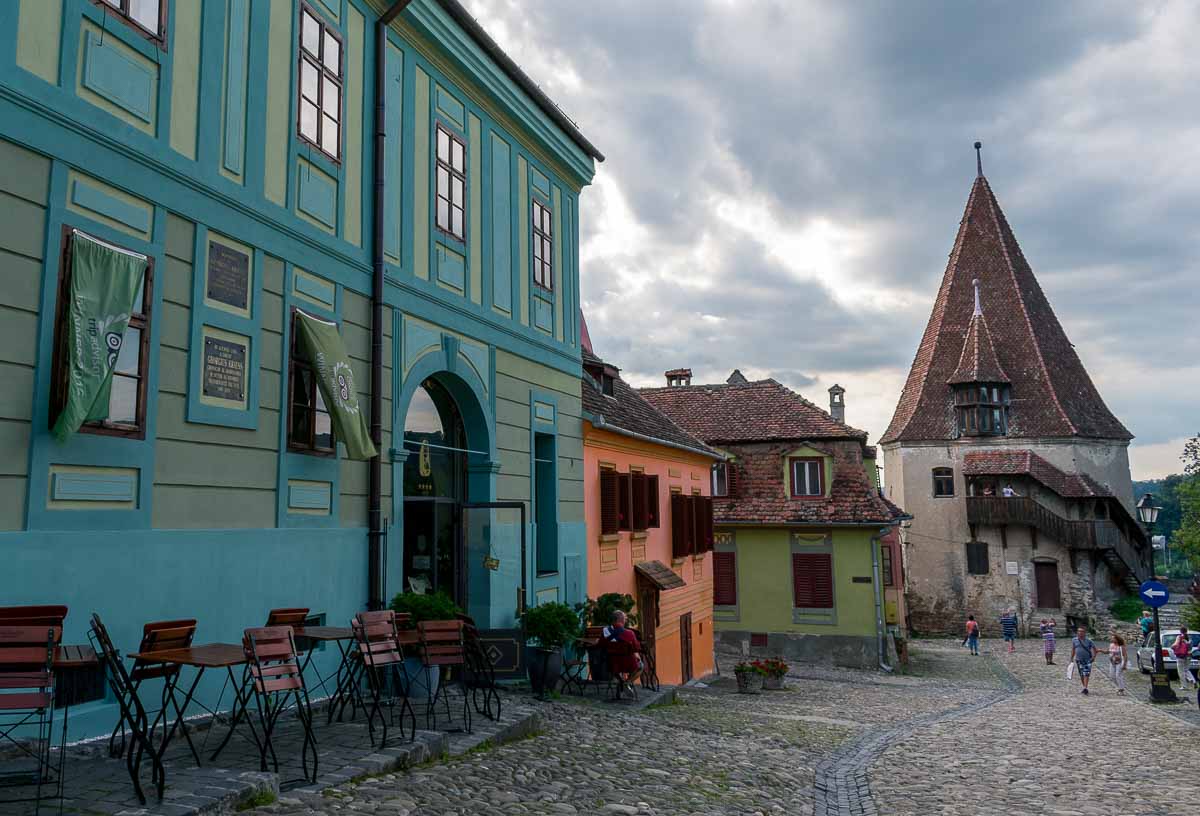
The fairytale-like main square (Piata Cetatii), the Scholars’ Stairs and the Clock Tower are among Sighisoara’s major attractions. That said, the absolute star of the town is no other than the infamous Dracula himself. Sighisoara is considered Dracula’s birthplace and one can visit the house where he was born and lived during his early childhood years for a small fee.
Most travellers visit Sighisoara on a day trip from nearby Brasov or even Bucharest. However, an overnight stay at this gem of a town is mandatory for so many reasons. First of all, it is in the evening, when the hordes of day-trippers are gone, that dimly-lit Sighisoara looks prettier than ever. Most importantly, though, the opportunity to spend the night right in the heart of a fortified medieval settlement doesn’t come up every day so it shouldn’t be missed.
Sighisoara is accessible by train from Bucharest and many other Romanian cities. Moreover, Sighisoara is connected by train to a couple of other European capitals as well, such as Budapest or Vienna. Yet, driving is probably the best way to get to Sighisoara as part of a longer road trip across Transylvania. The latter is a stunning region, abundant in natural and cultural treasures that are patiently waiting to be discovered.
Budapest, Hungary
by Giulia, Travelling Sunglasses
So many layers of history are visible in Budapest, the capital of Hungary, from Roman settlements to Art Nouveau. Strolling through the city centre of Budapest feels like travelling in time. Buildings side by side show the evolution of architectural styles. The signs of passing time are visible on the façades, as well as dramatic bullet holes from the past wars. 19th-century buildings house clubs or tech stores on the ground floor, providing for exciting contrasts and examples of real life.
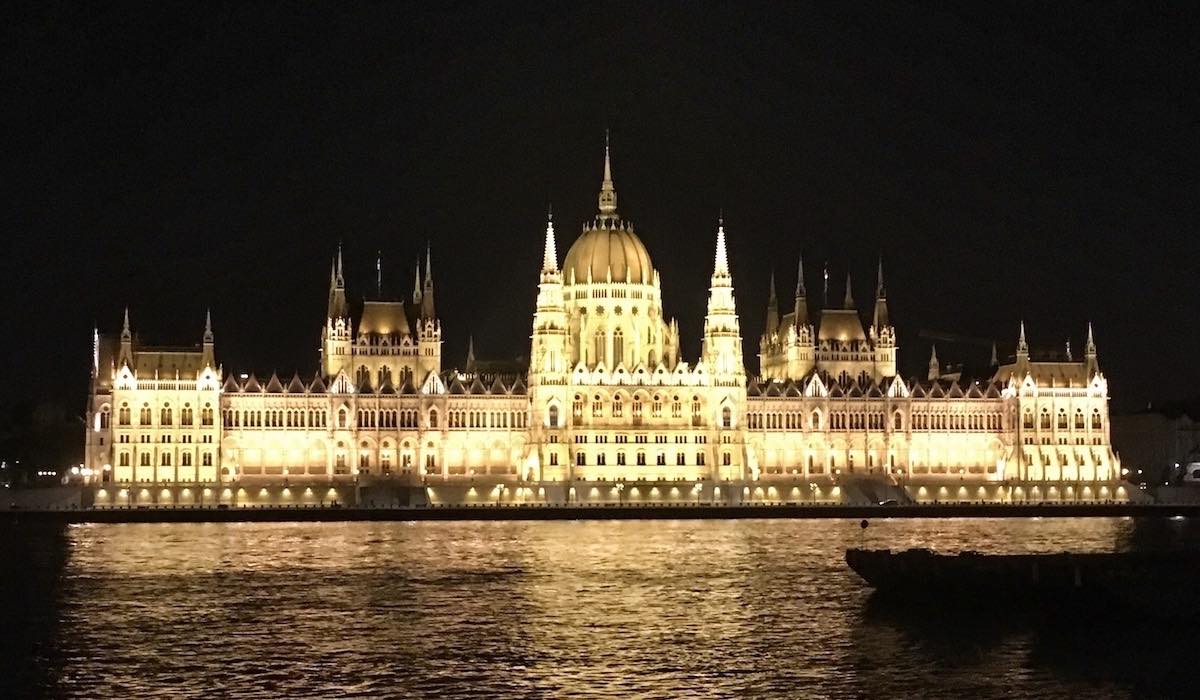
Thanks to the sensible reconstruction and restoration, which kept the authenticity and integrity of the city centre, two areas are among the Unesco World Heritage sites in Europe.
The official term of “Budapest, the banks of the Danube and the Buda Castle Quarter” can be easily separated into two parts.
The banks of the Danube river include both Buda side (West) and Pest (East). Incredible buildings are located in Pest, such as the Parliament, the Hungarian Academy of Science and the Great Market Hall, with many more in the buffer zone. In Buda, the impressive Gellert Hill is topped by the iconic Statue of Liberty, and the Aquincum ruins north of the city remind us of the Roman origins of Budapest. Of course, the bridges that cross the Danube are included, such as the scenic Chain Bridge.
Buda Castle Quarter is all located on Buda Castle Hill. Buda Castle itself was modified, expanded and rebuilt multiple times over the centuries; the streets surrounding it maintained an Austrian, medieval feeling about them. One of the most famous landmarks of Budapest, Mathias Church and the Fishermen Bastion, is nearby.
The third area is Andrassy Avenue and Heroes Square. The Avenue includes gorgeous 19th-century buildings, the Opera house, harmonic squares lined by trees, which lead to the majestic Heroes Square and to the city park Varosliget. Below all of this, the Millennium Underground Railway is still running, the first metro in continental Europe.
Upper Svaneti region, Republic of Georgia
by Maggie Turansky, The World Was Here First
If you want to visit an absolutely beautiful and remote UNESCO World Heritage Site, then head to the Upper Svaneti region in the Republic of Georgia. You cannot go wrong.
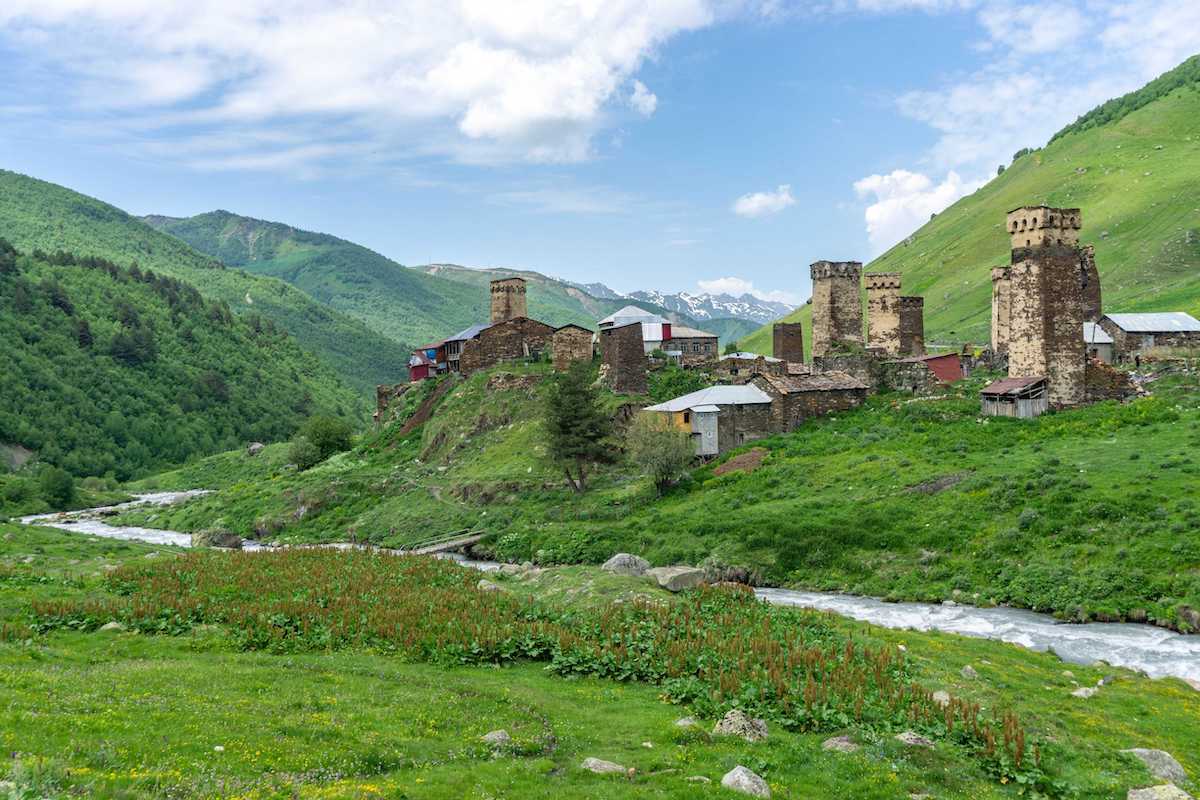
As one of the most remote and hard-to-reach areas in Europe, Svaneti has its own unique culture. Furthermore, it’s home to both incredible landscapes and fascinating mountain villages that will make you feel as if you were transported back in time. The region is famous for being home to Ushguli, the highest-elevation town in Europe that is continuously inhabited.
Svaneti is also famous for its Svan towers, stone towers that adorn the villages in the region that were built for lookout and defence, the oldest of which date back to the 8th and 9th centuries.
While Mestia is the unofficial capital of the region and the biggest town in Svaneti, there’s a lot to see and do in the area. It is indeed an essential addition to any travel itinerary through Georgia. If you have time to spare and love getting out in nature, do the famous Mestia to Ushguli trek. It’s a fantastic four-day trek that takes you through several smaller villages along the way to remote Ushguli.
Pecherska Monastery, Ukraine
by Chris Backe, Worthy Go
Next to Chernobyl, the Kiev-Pechersk Lavra (AKA Pecherska Monastery) in Kyiv, Ukraine is probably the best-known tourist destination in the country. Inscribed as a World Heritage Site in 1990, the series of religious buildings were constructed in the 11th century. Designed to rival the Hagia Sophia complex in Constantinople (now Istanbul), Turkey, there’s a ton of beauty in the buildings that remain, and plenty to see once you’re here.
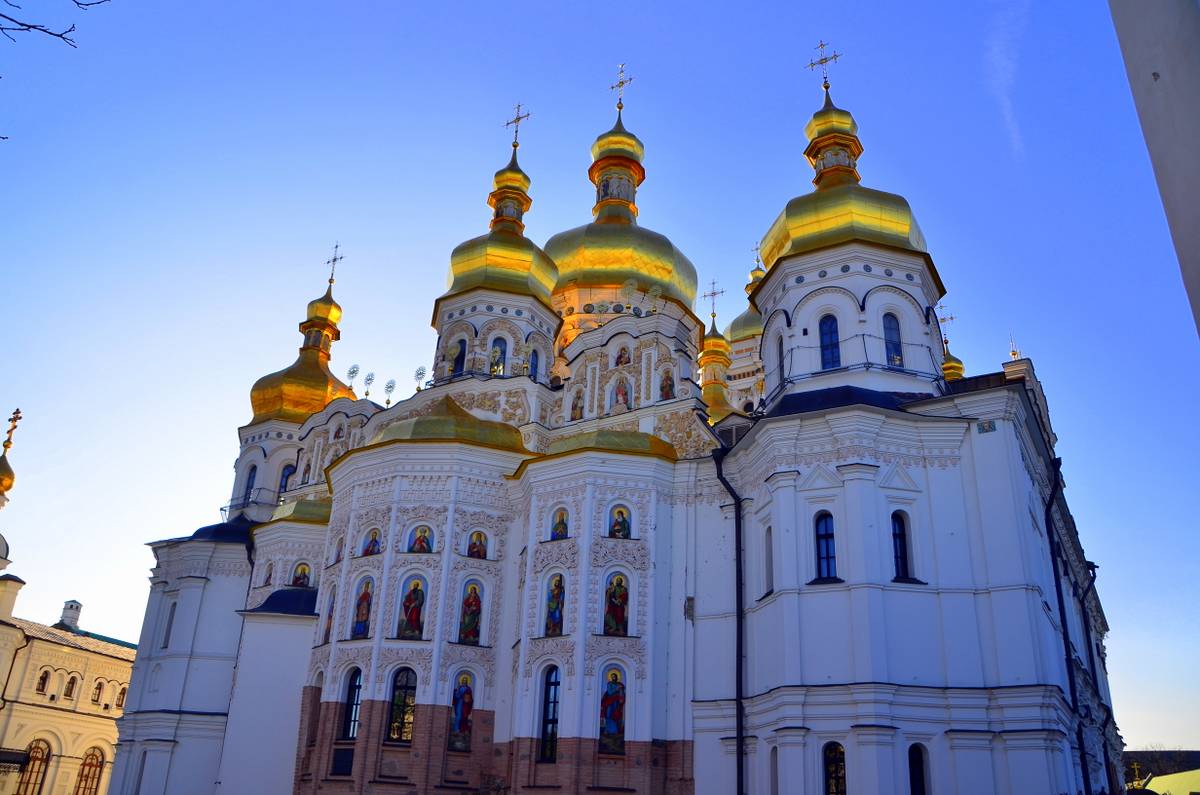
For tourists, it’s a classic look at the gold-topped Orthodox churches of the Eastern variety. Construction on some buildings is ongoing (and may continue for decades to come). And some areas have definitely been repurposed (what were monk’s living quarters might now be a souvenir shop or a place to get some coffee).
The site has been modernized in some ways and now includes a Microminiatures museum with a separate entrance fee. Pay attention to the signage near the entrance to ensure you get the ticket you want.
For pilgrims, the main stop will be a short walk away at a separately-run system of nearby caves. These are free to enter, but you’re encouraged to buy a candle to help light your way. These are very cheap (between 5-10 hryvnia, or $0.21-$0.42 US), and really help to enhance the pilgrimage feel of the place. It’s possible to navigate the narrow passageways without a candle, but it’s dark and crowded. Go slow and savour the experience.
*****
As you can see, there’s no shortage of stunning UNESCO World Heritage Sites in Europe, and this list is by no means comprehensive. On your next trip to Europe, go and visit at least one of them, possibly off-season.
______
This post contains affiliate links. If you make any purchase, I get a small commission at no extra cost to you.
Pin for later!
